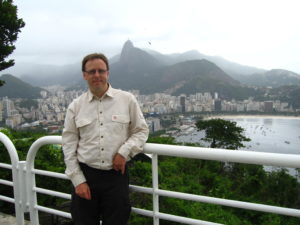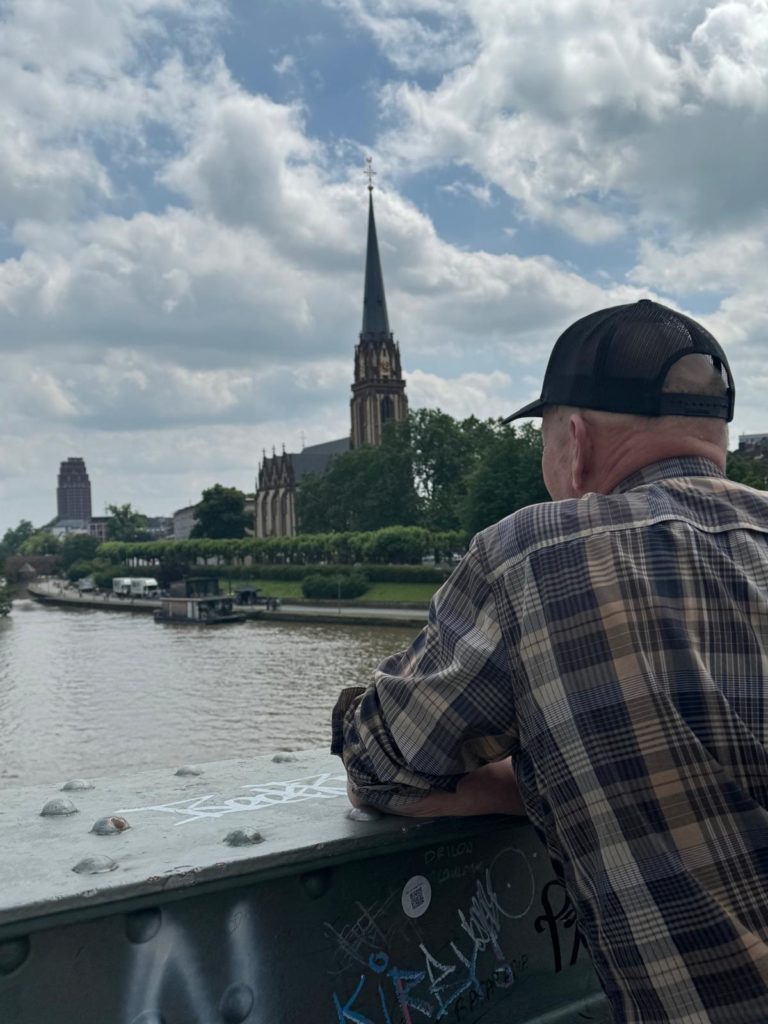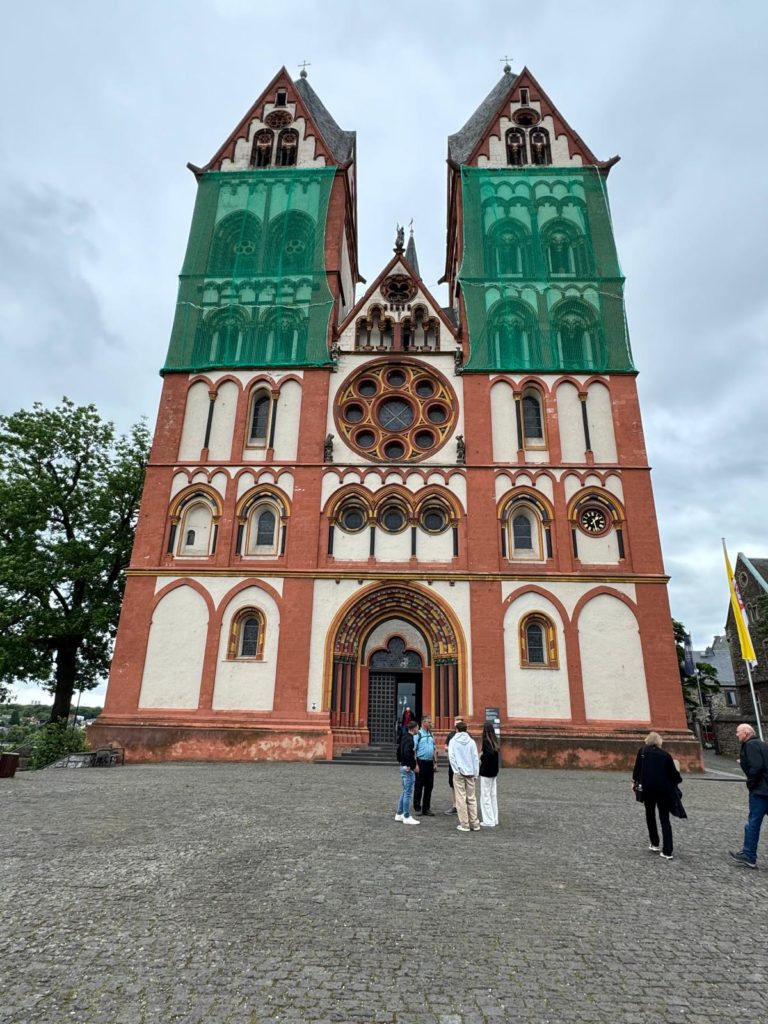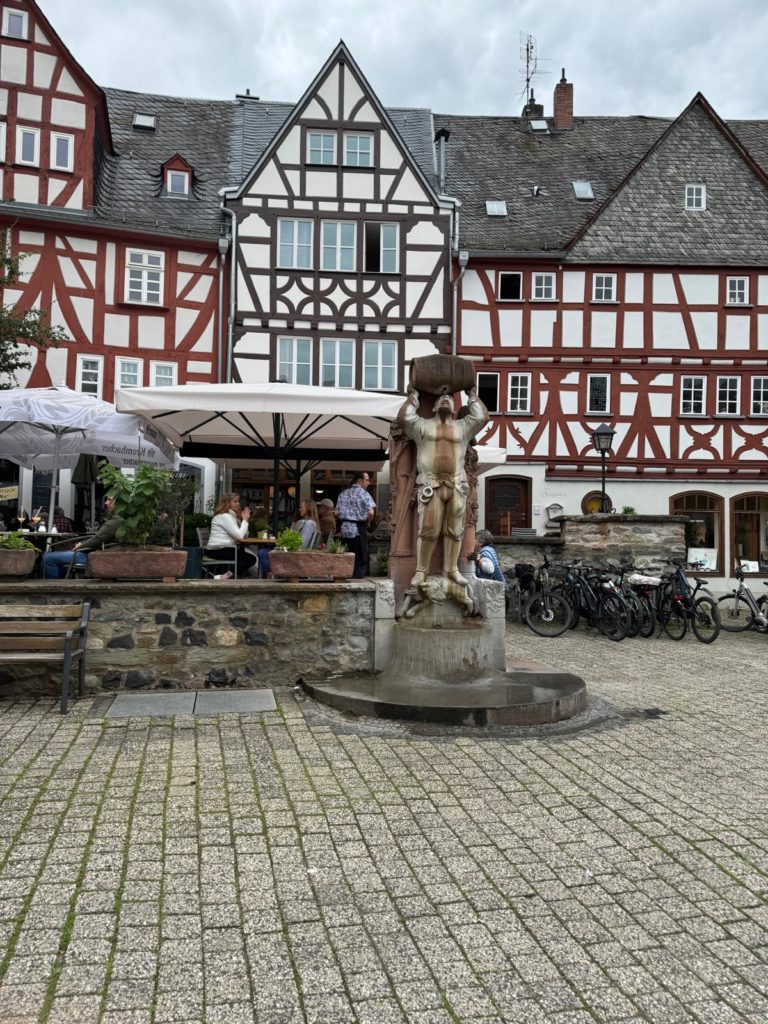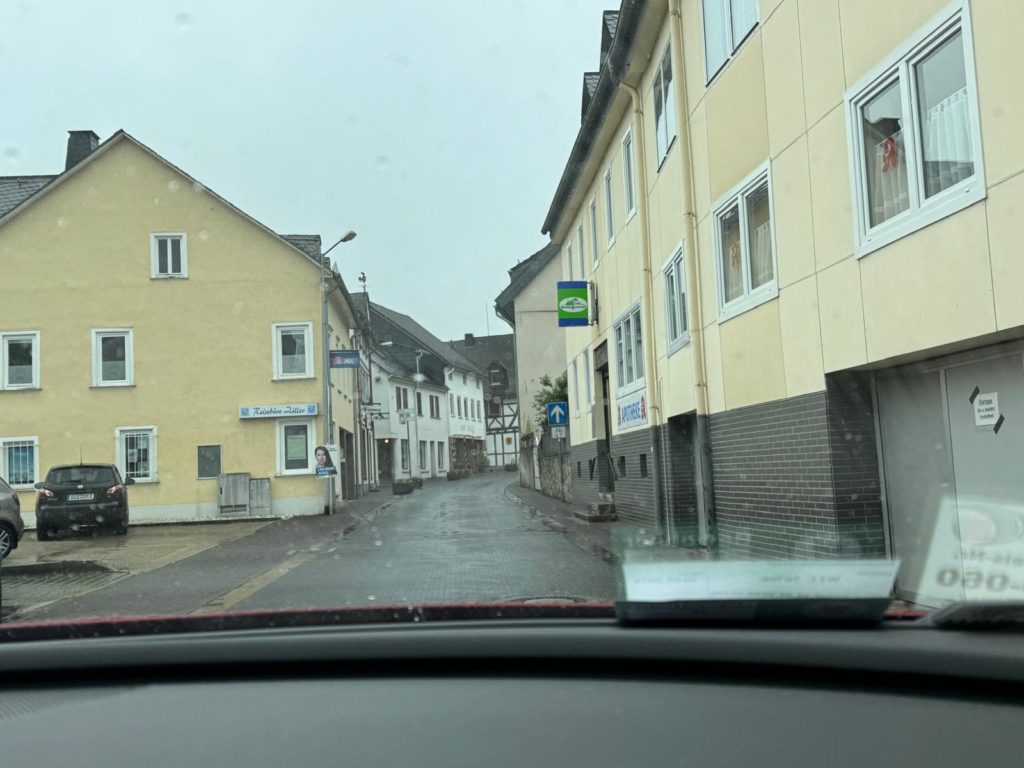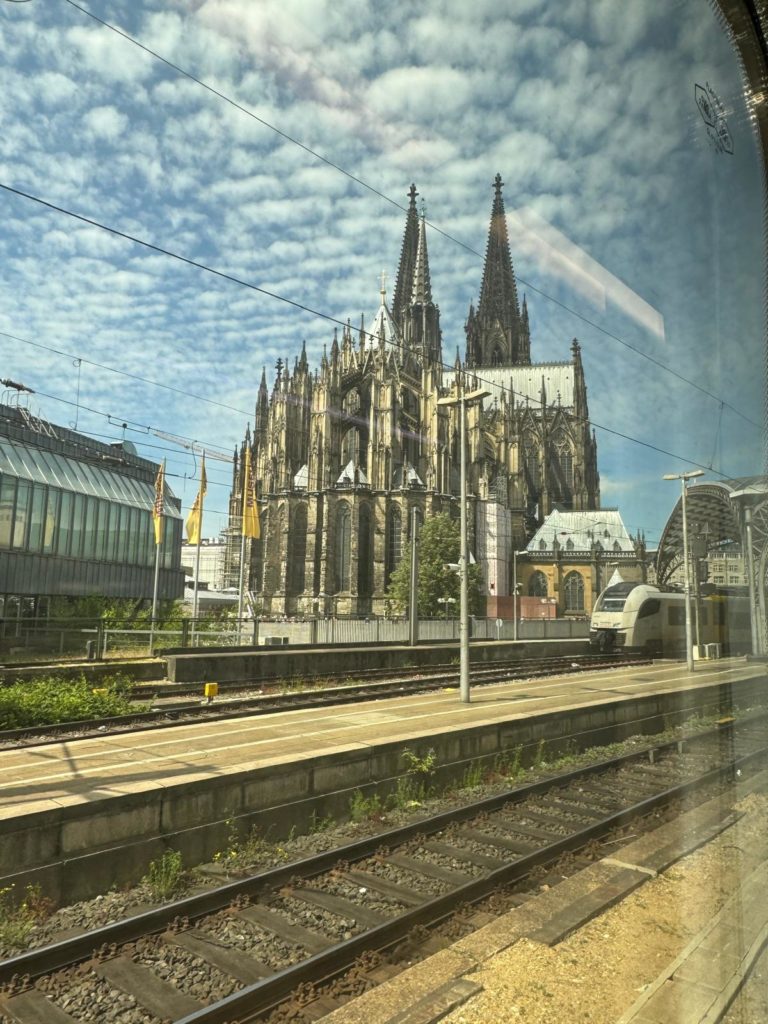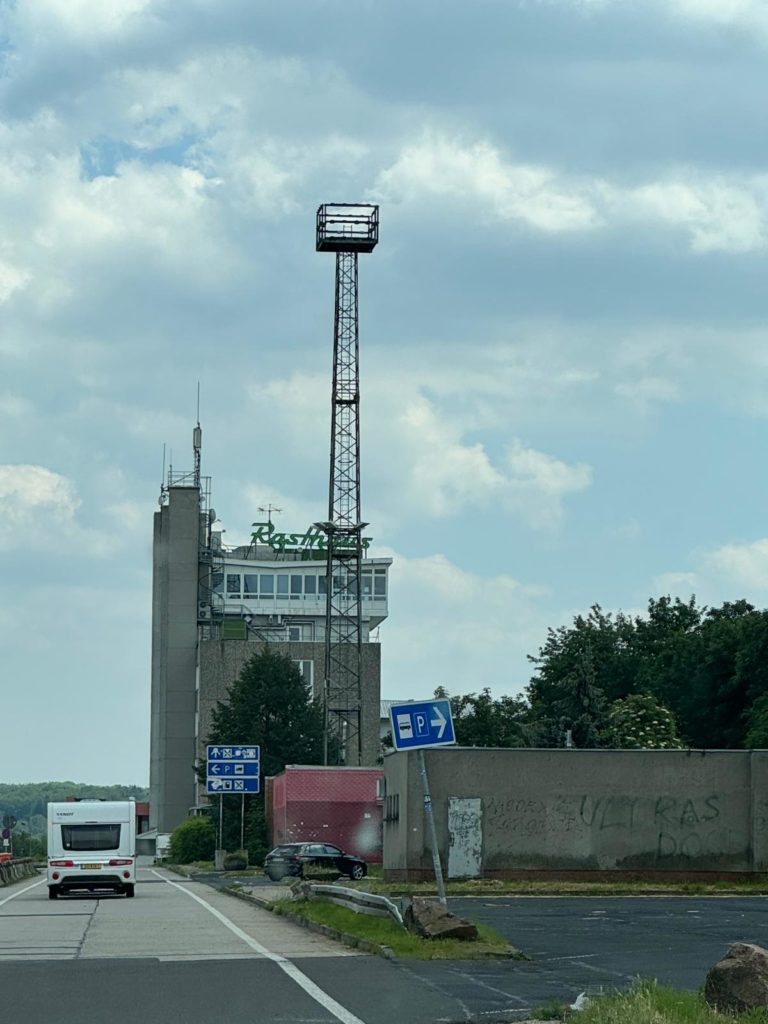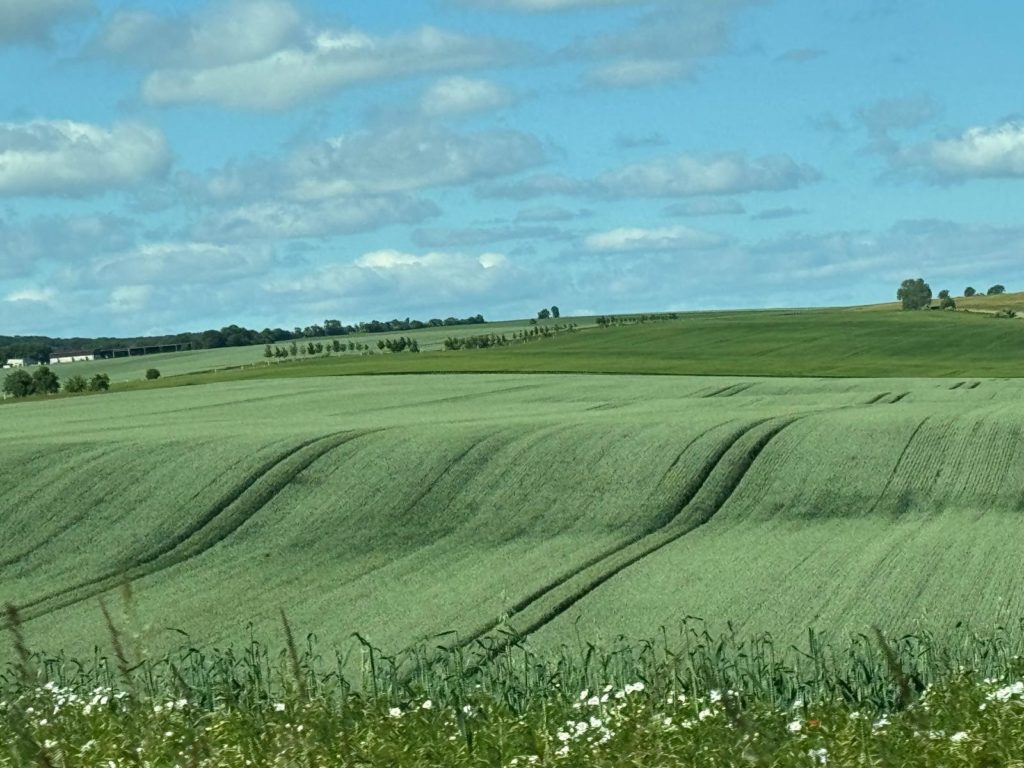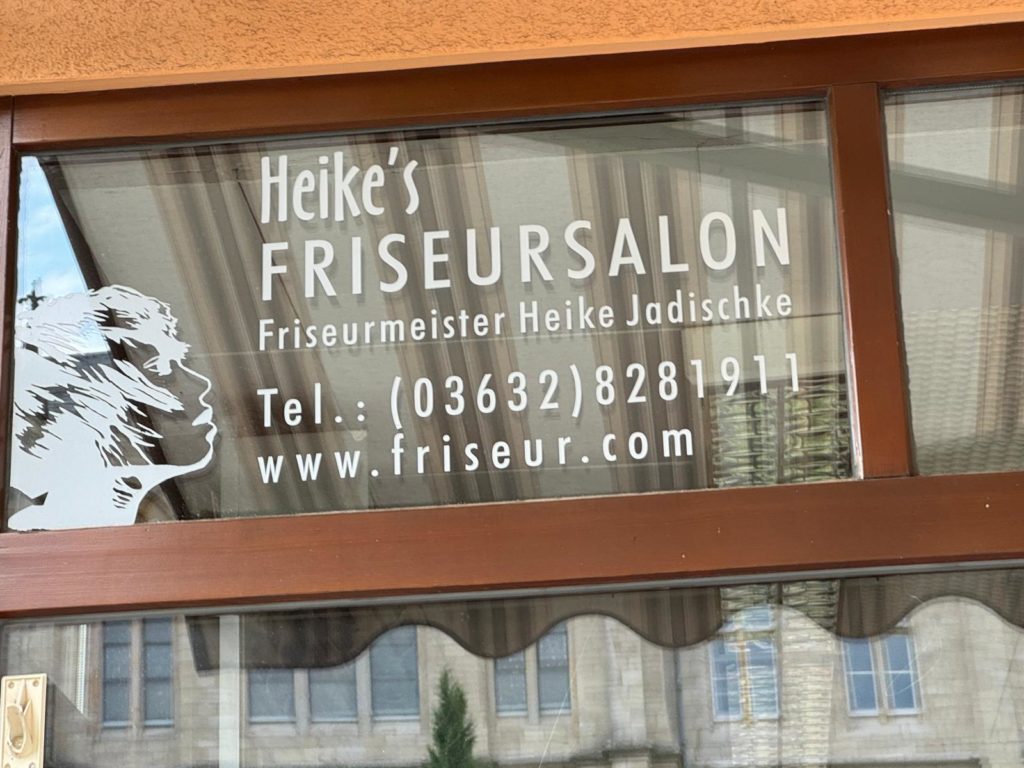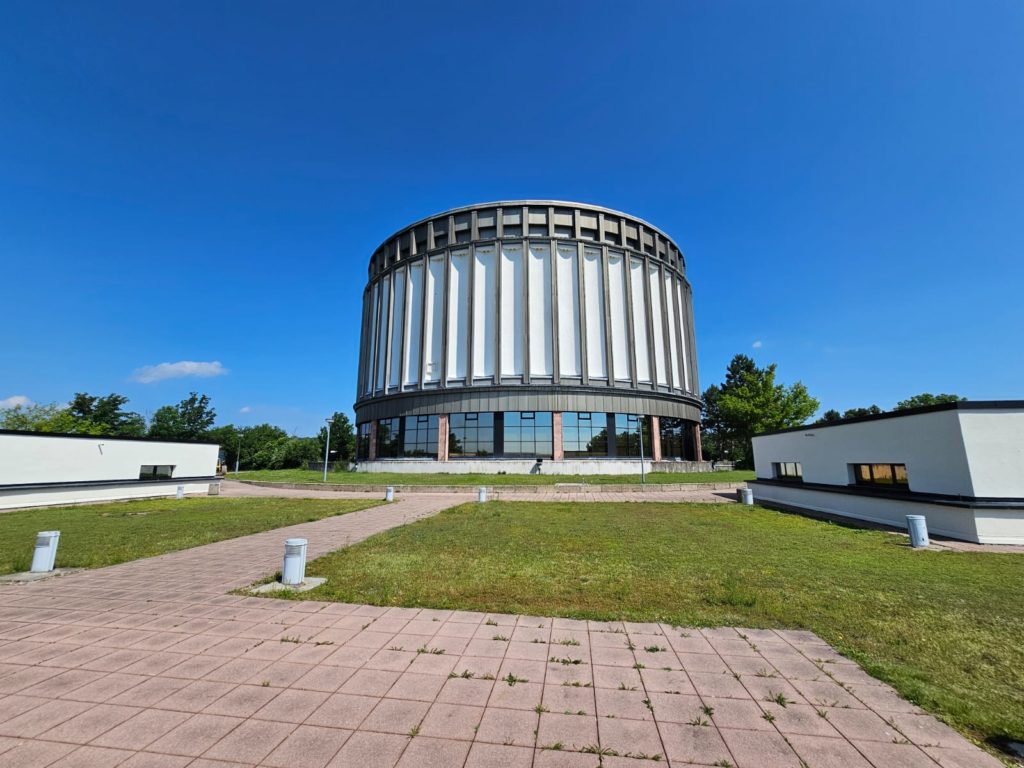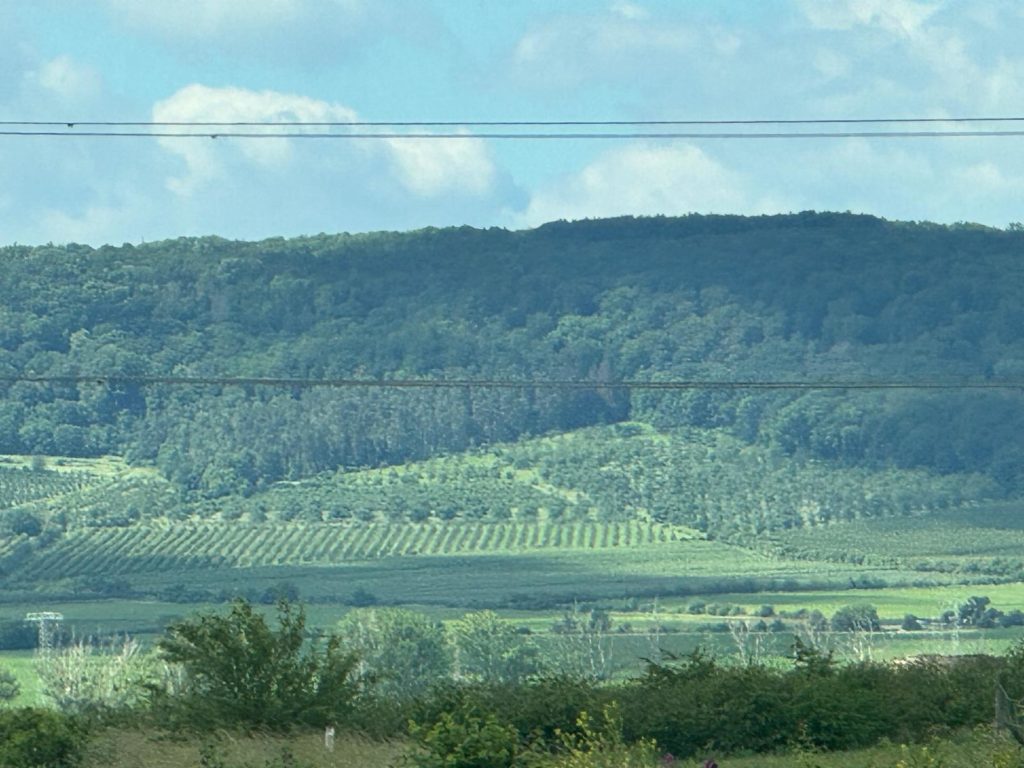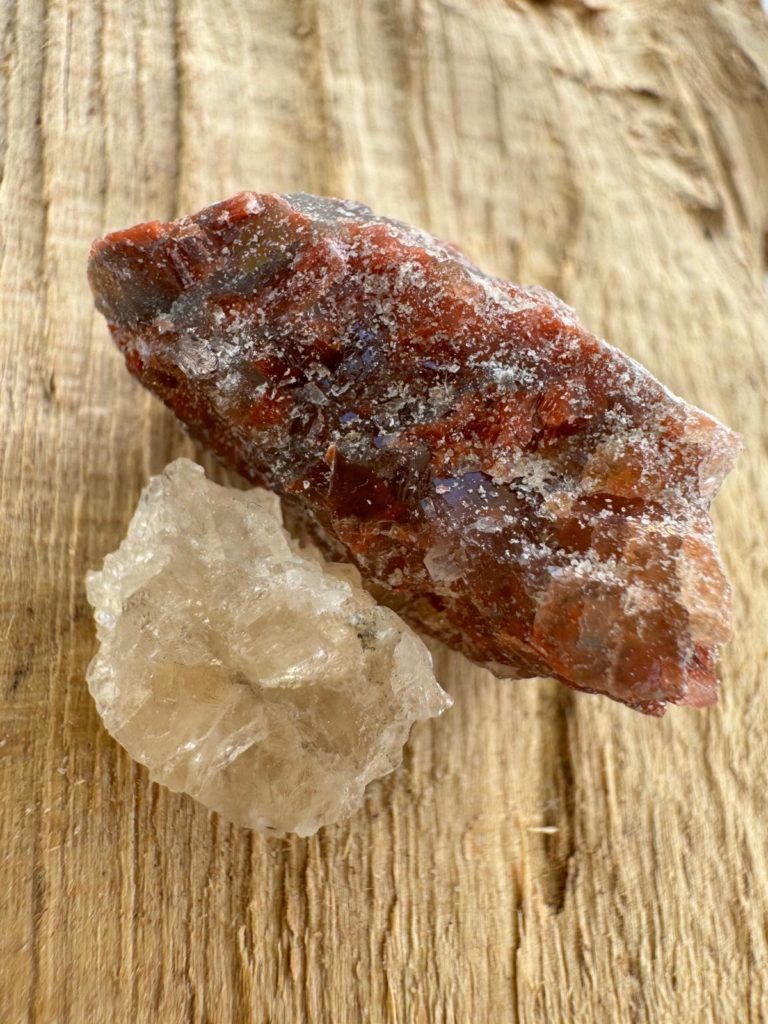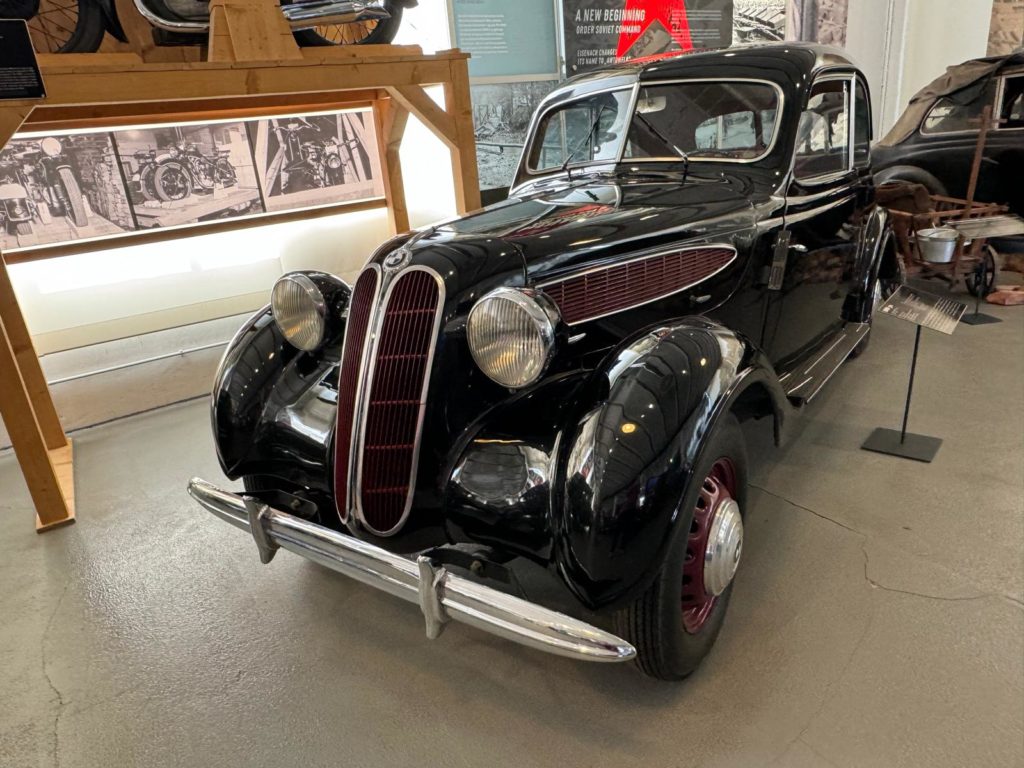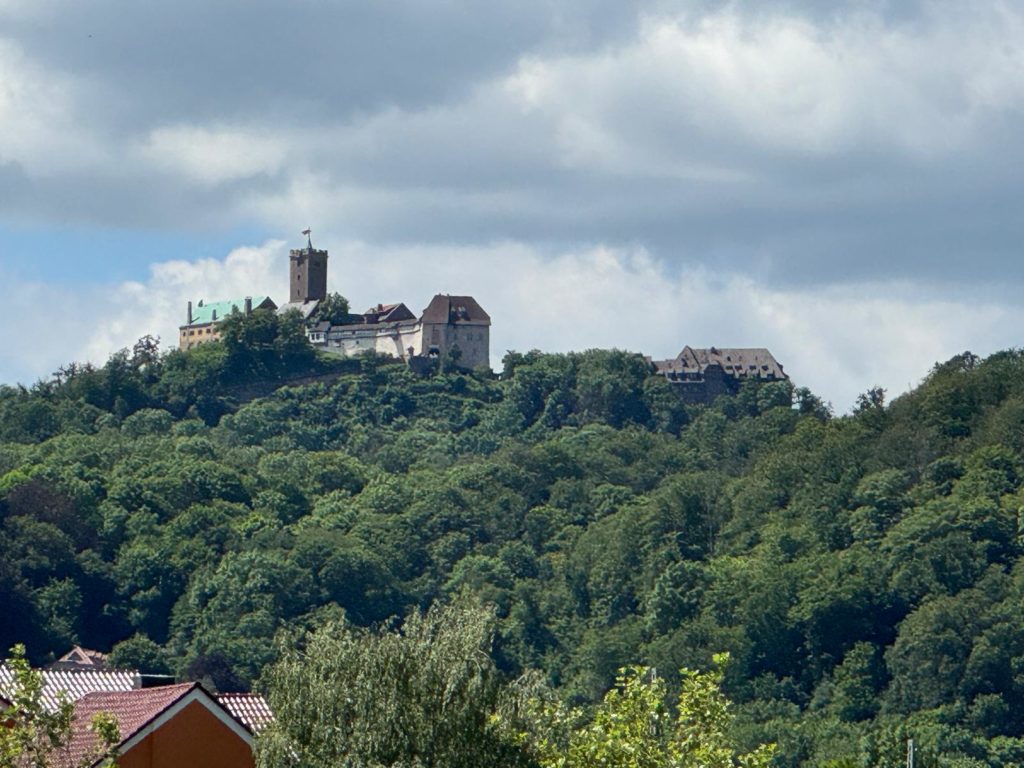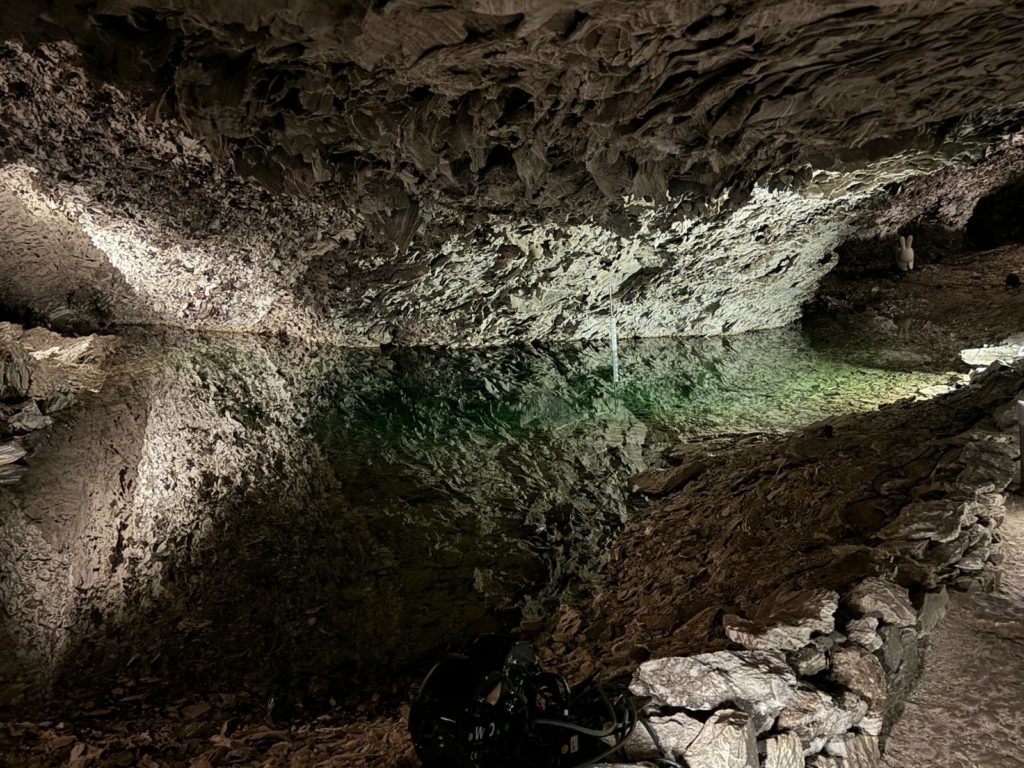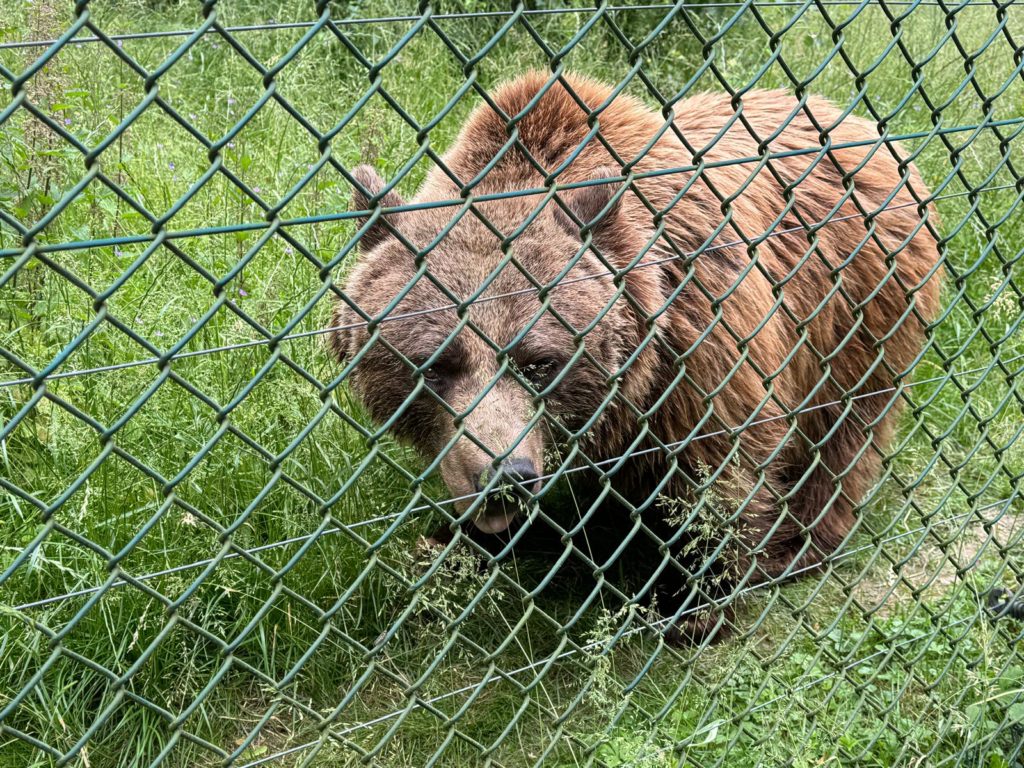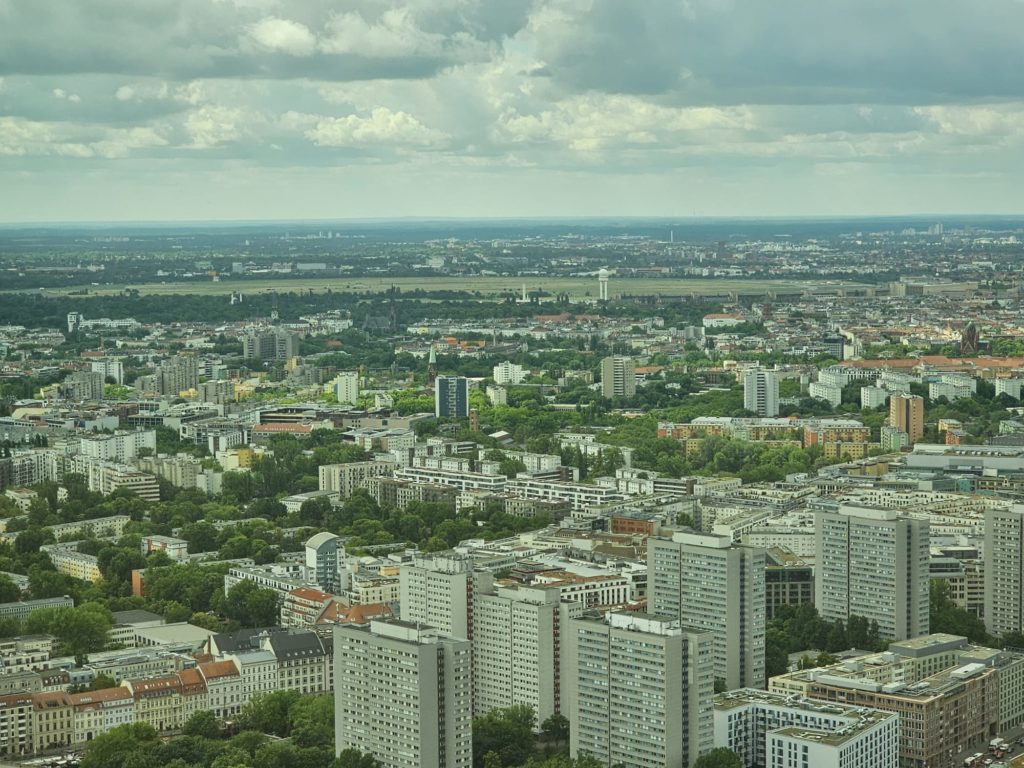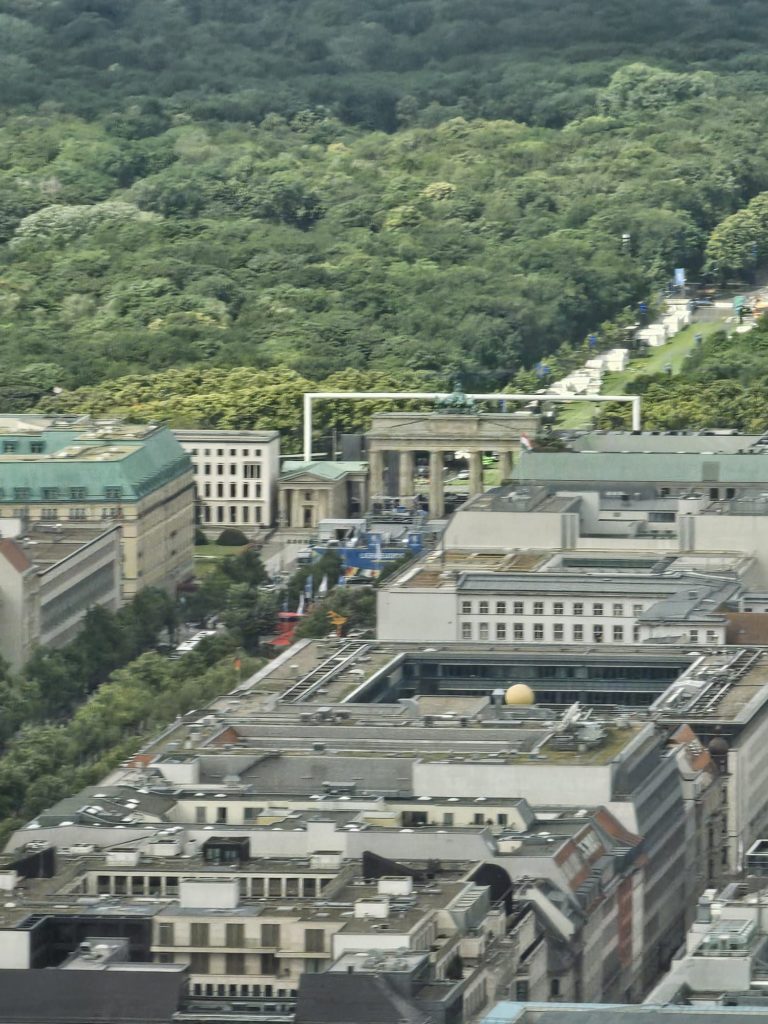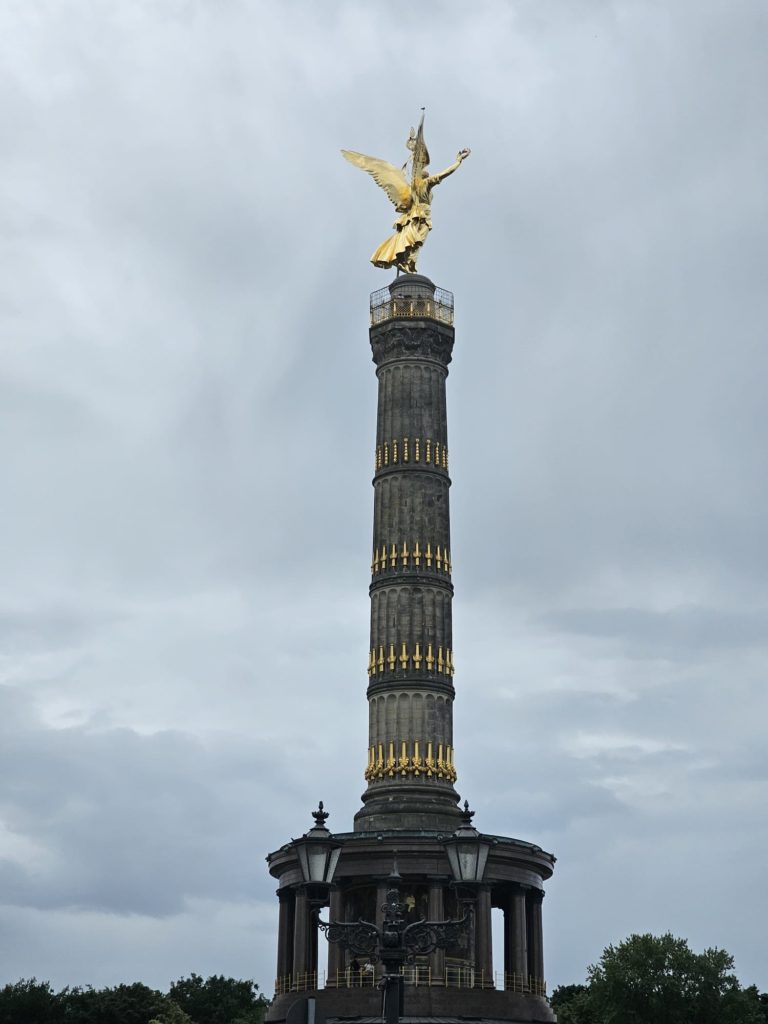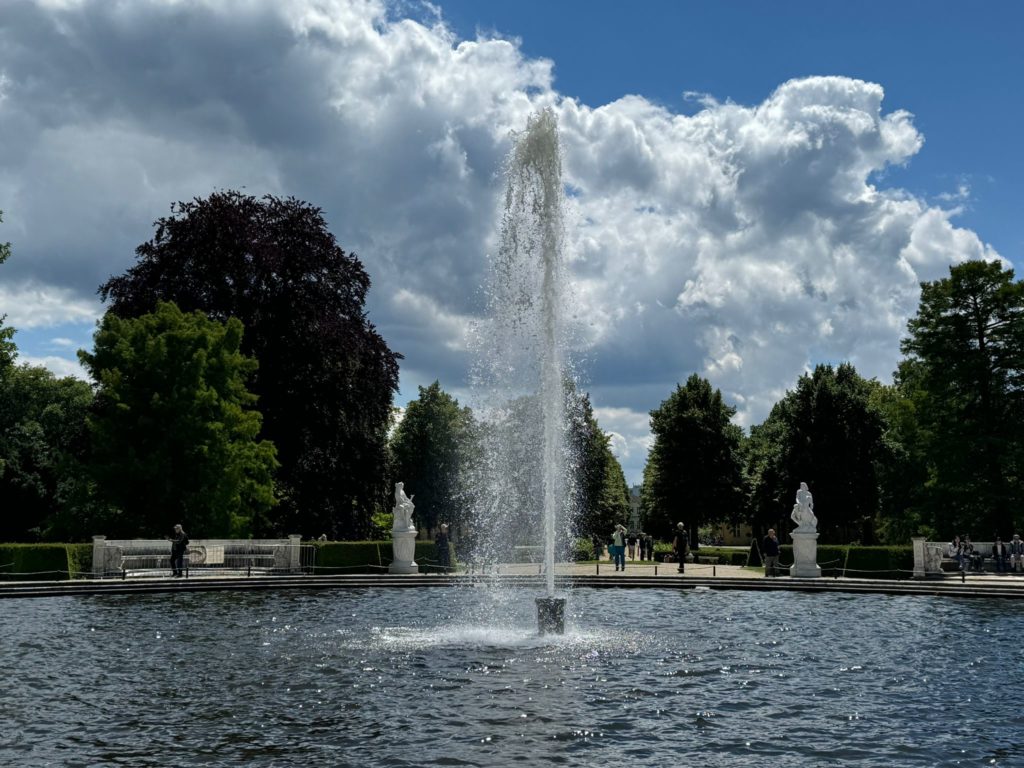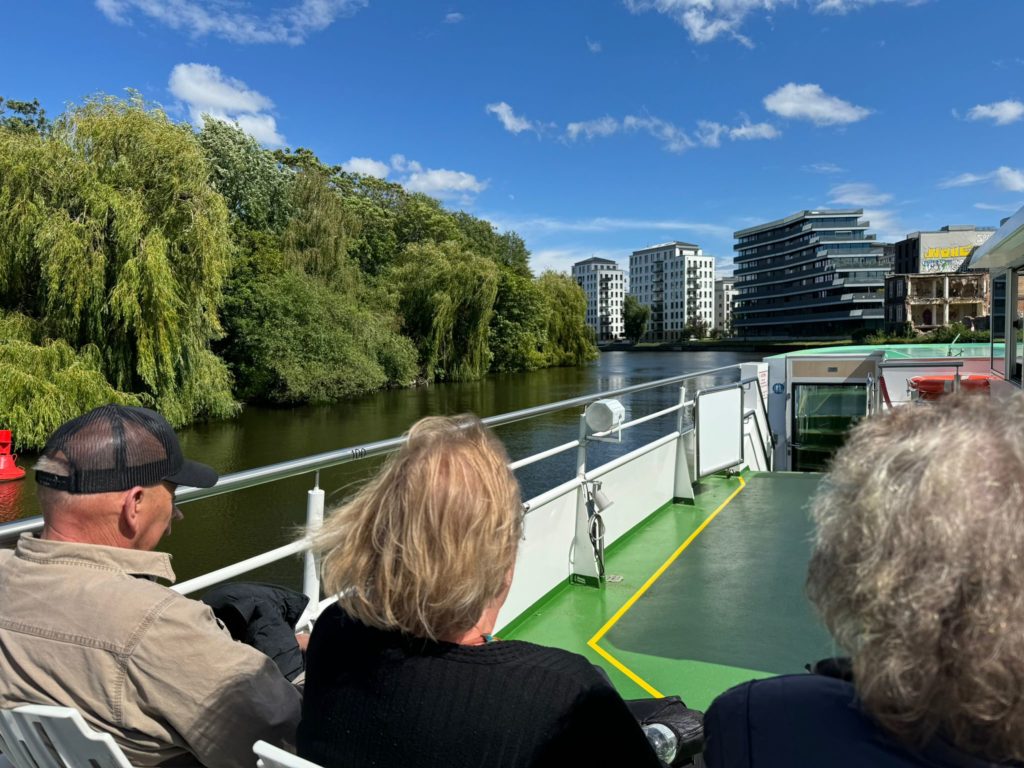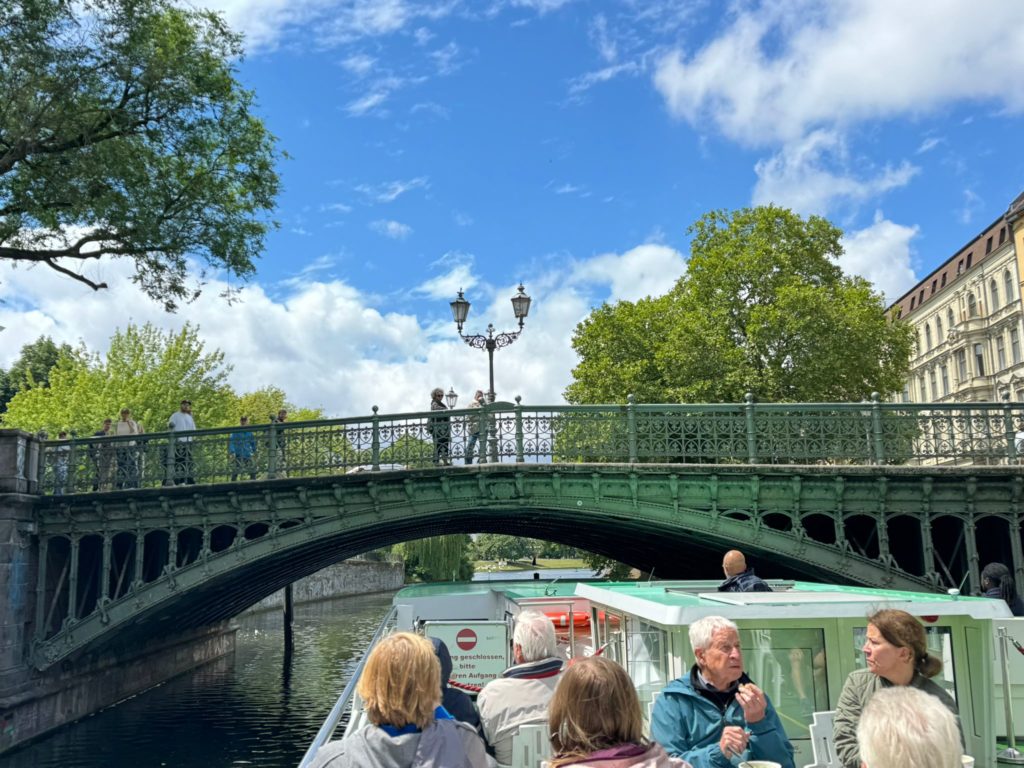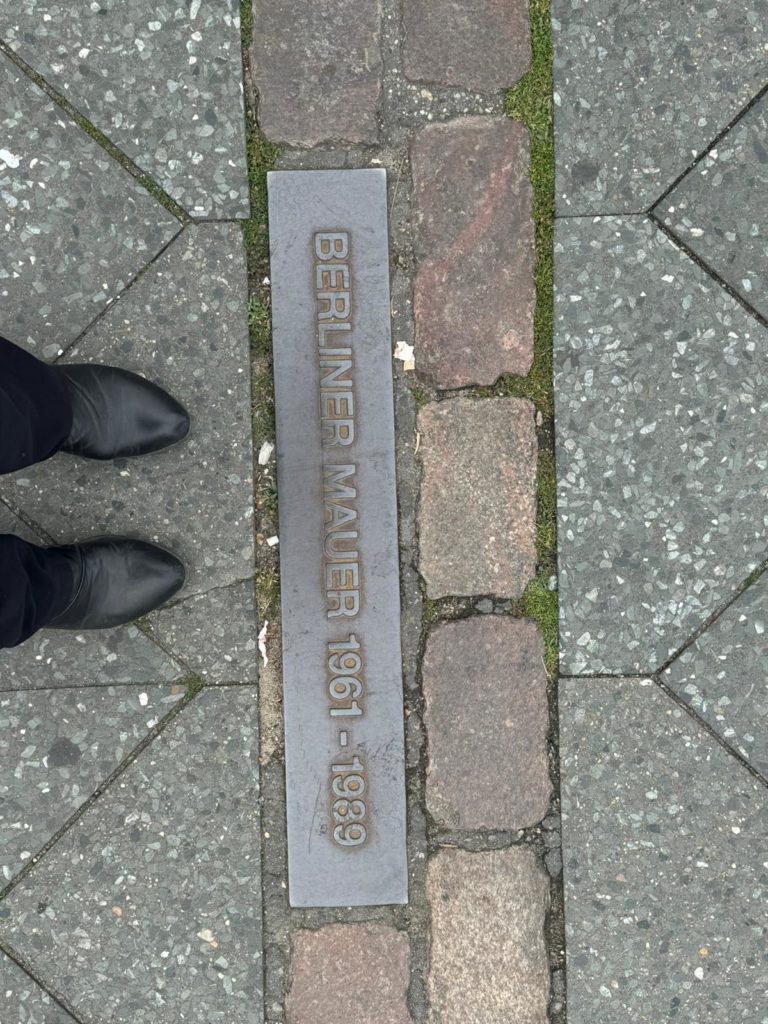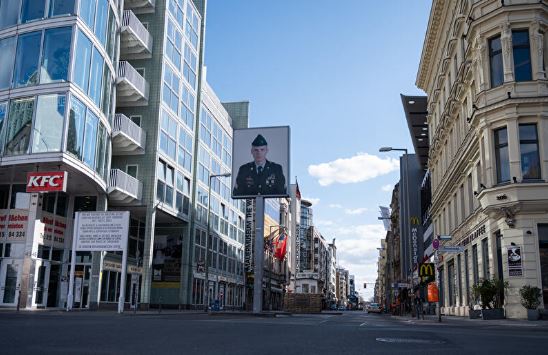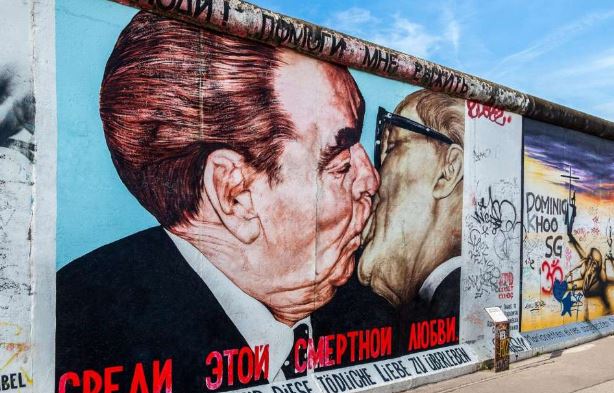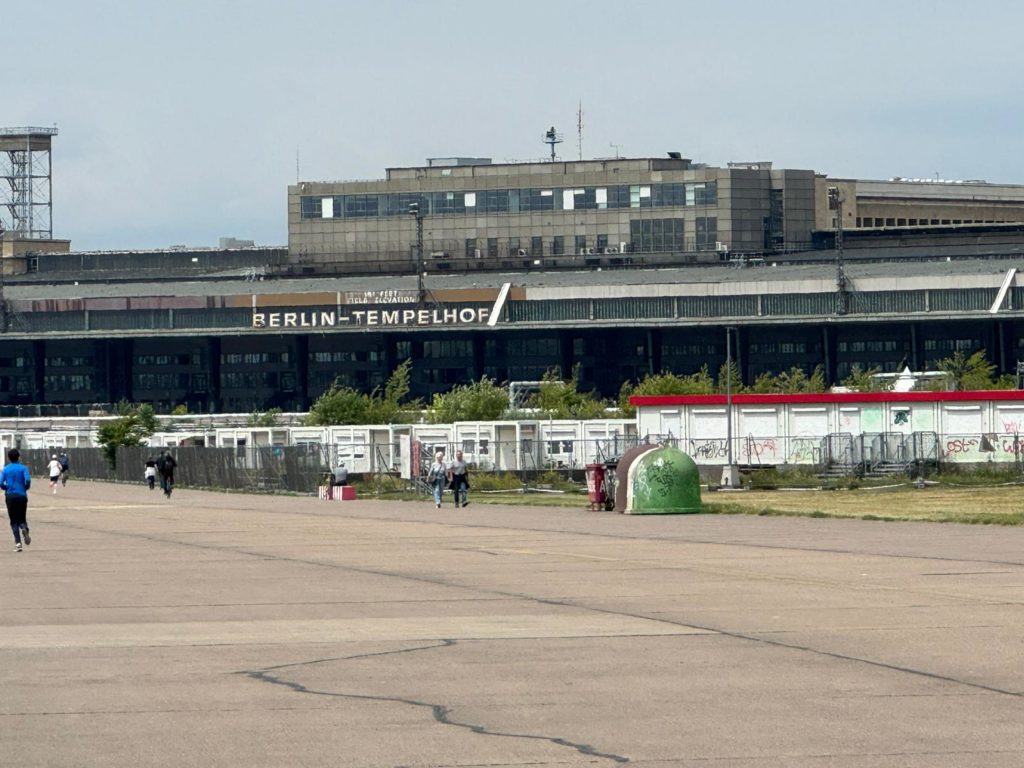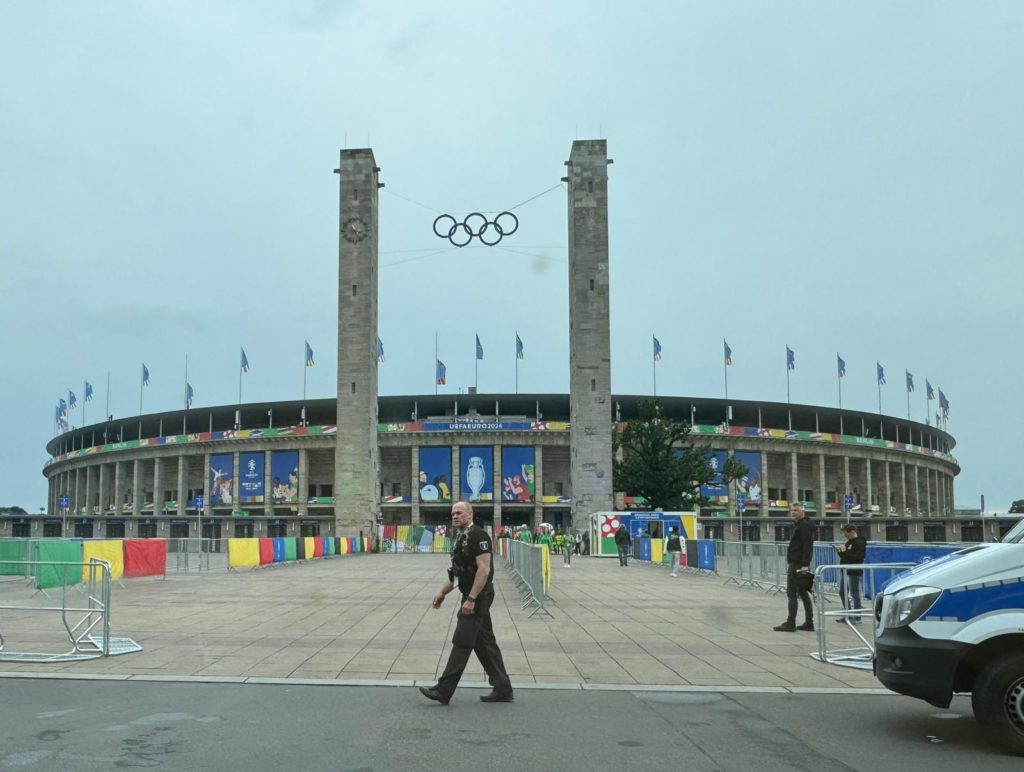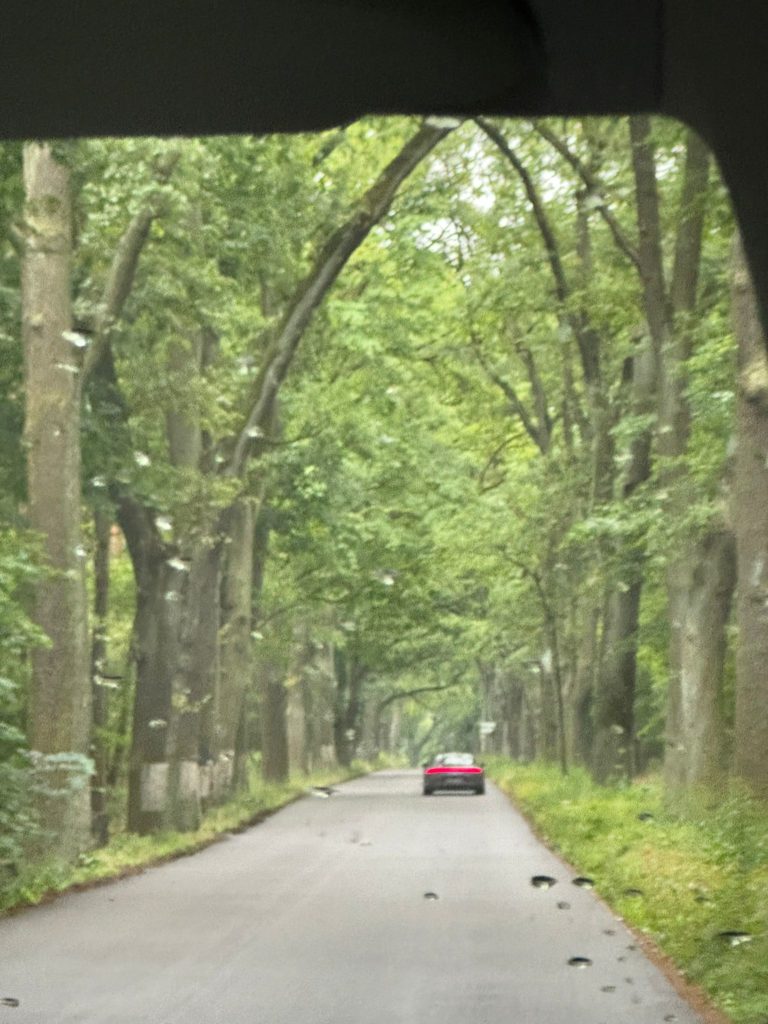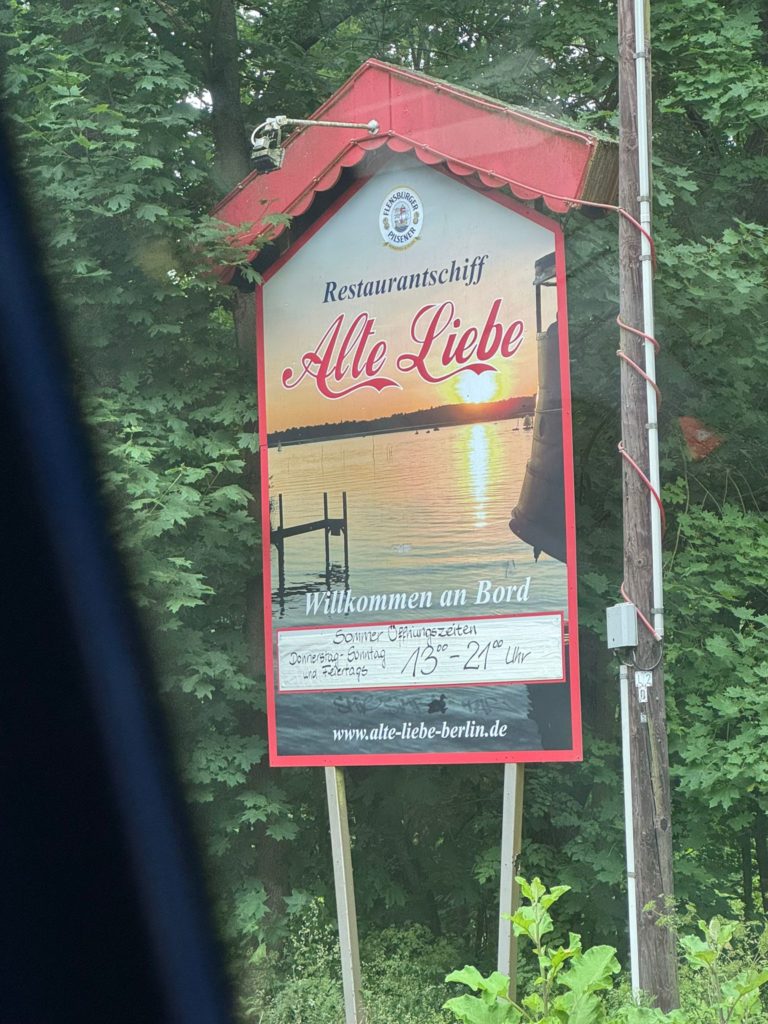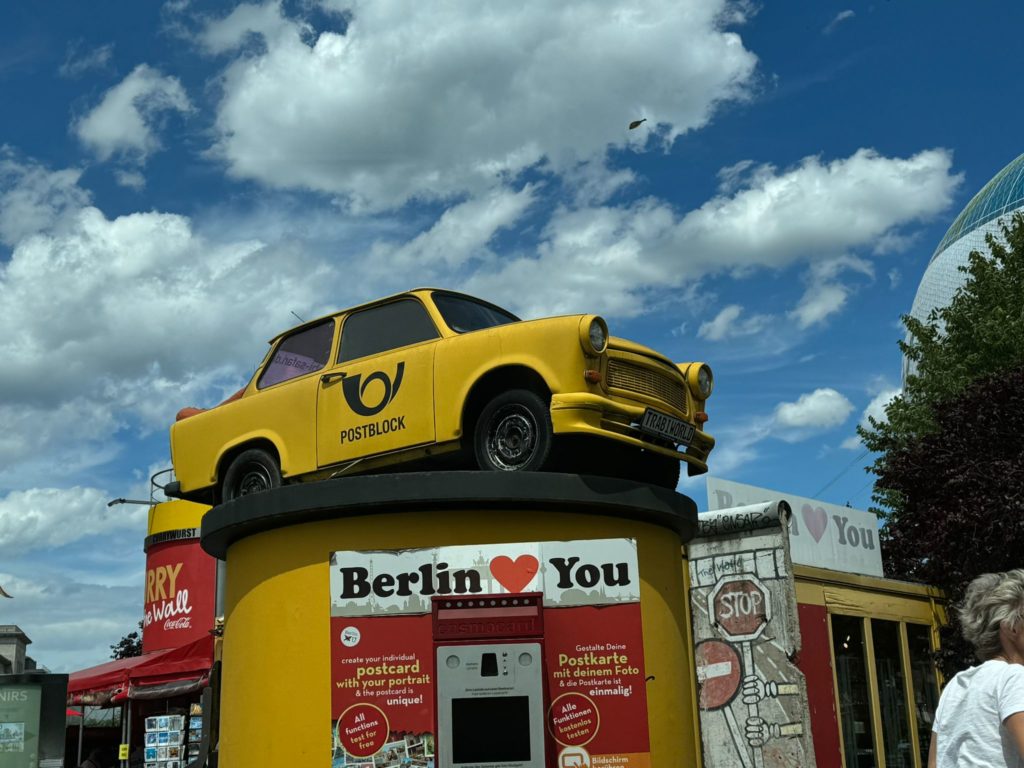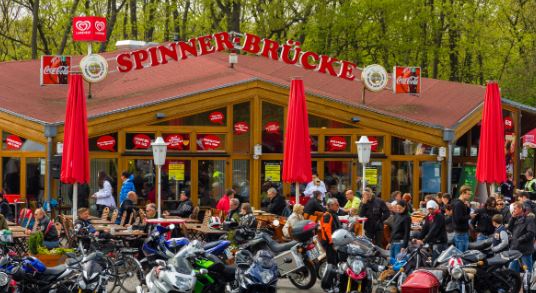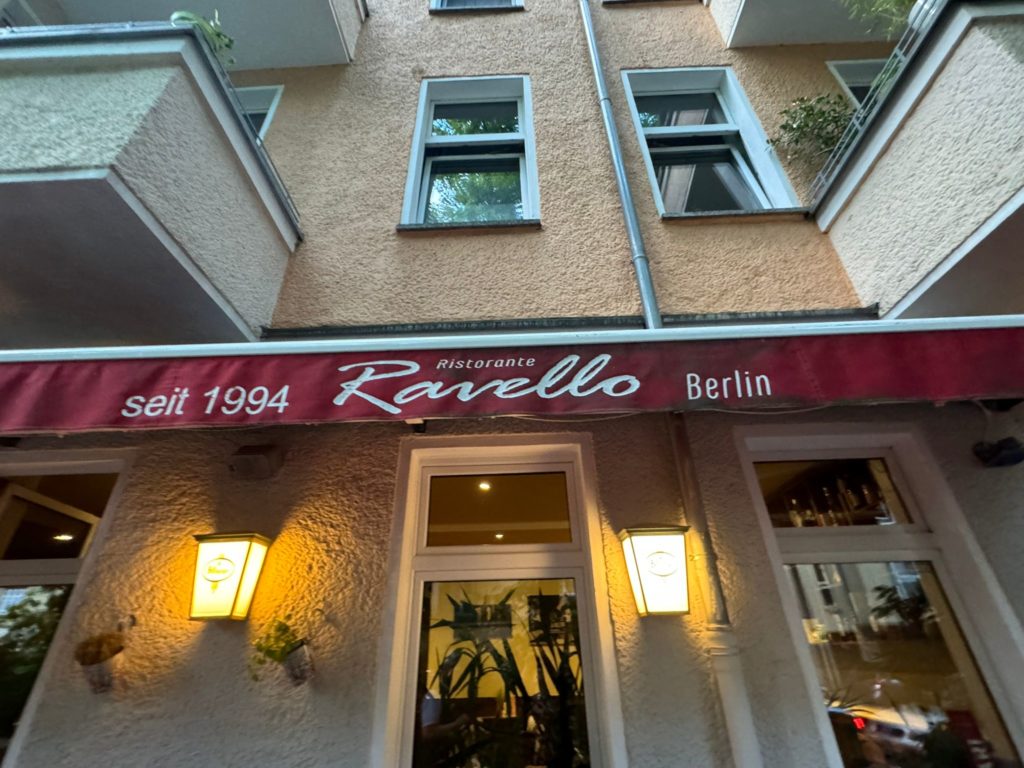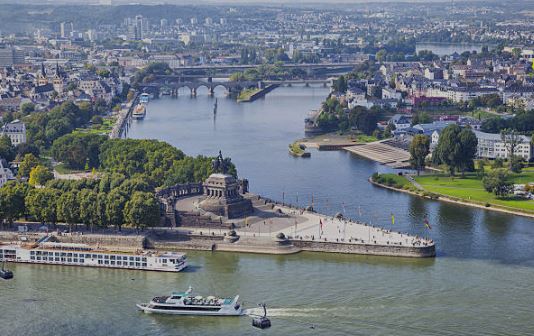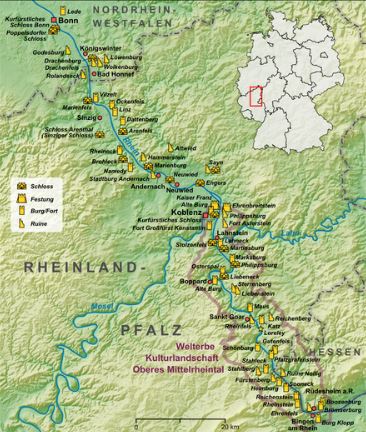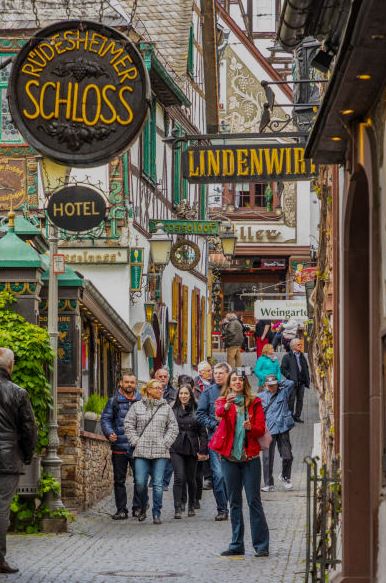Germany Tour June 2024
I went on a vacation trip through western and central Germany with cousins from my Canadian branch of the family from June 4th, 2024 to June 19th, 2024.
The focus of the trip was primarily on visiting our relatives, some of whom had not seen each other for over 50 years.
We mainly spent our time together in Hesse, Thuringia and Berlin.
June 4th, 2024 Kelsterbach, Rüsselsheim and Frankfurt am Main
My Canadian cousins landed at Frankfurt Airport early in the morning of June 4th. I picked them up from the airport and we spent the first day of vacation together, which was mainly characterized by jet lag. After a light breakfast we took it easy. From my apartment in Kelsterbach we took a short tour by car through the surrounding area. We first drove to the Opelstadt in Rüsselsheim. Opel is an old, traditional German brand that primarily produces automobiles. It was founded in the 19th century by Adam Opel in Rüsselsheim. They first manufactured sewing machines and later bicycles. After the founder’s death, Adam Opel’s sons took over the company. They started making automobiles. In 1929 they sold their company to the American automobile company General Motors. After almost 100 years of ownership, GM sold Opel to the French PSA Group. In 2021, PSA merged with FCA (Fiat/Chrysler) to form the newly formed Stellantis Group with 14 car brands (Chrysler, Dodge, Jepp, Ram, Fiat, Lancia, Alfa Romeo, Maserati, Abarth, Peugeot, Citroen, DS, Opel and Vauxhall) . Approximately 14,000 employees currently work at Opel in Rüsselsheim. The Opel Astra and DS 4 models are currently being produced in Rüsselsheim. After driving around the Opel factory, we took a detour through the Frankfurt airport area to downtown Frankfurt. We then visited Frankfurt by foot. We made a loop from the Hauptwache to the Main Tower and back. Then across the square in front of the Paulskirche, to the Römer, the old town of Frankfurt and the imperial cathedral with the chapel in which the Roman-German kings were elected and crowned by the electors from the 14th century to the end of the 18th century. We then crossed the Main at the Eiserner Steg bridge and stopped for a late lunch in a traditional cider bar in the Sachsenhausen district. Then it was time to end the long day of travel and check into the hotel.
The history of Frankfurt is the story of the development from an imperial palace to one of Europe’s banking metropolises. The beginning was marked by a Main-river ford and the cathedral hill including today’s Römerberg. Frankfurt was first mentioned in a document from Emperor Charlemagne dated February 22, 794. On August 10, 794, Fastrada, Emperor Charlemagnes‘ fourth wife, died in Frankfurt. He left the place and never returned. Louis the Pious, Charlemagnes‘ son, chose Frankfurt as his residence, expanded the royal court into the Royal Palace of Frankfurt, had an even larger palace built and surrounded the city with walls and ditches in 838. After Emperor Friedrich I. Babarossa (Redbeard) was elected king by the electors in Frankfurt in 1152, this custom made Frankfurt the chosen city of the German kings until the end of the 18th century. In 1245 Frankfurt became an immediate imperial city. Even earlier, the citizens of Frankfurt elected their own mayors, who enjoyed the favor of the ruling emperor.
With around 800,000 inhabitants, Frankfurt am Main is the most populous city in the state of Hesse and the fifth largest city in Germany. Around six million people live in the Frankfurt metropolitan region. Frankfurt is one of the major cities in Germany with a decidedly multicultural society.
It is an international financial center, an important industrial, service and trade fair center and is one of the world’s economic cities. Frankfurt is home to the European Central Bank, the Deutsche Bundesbank, the Frankfurt Stock Exchange, numerous financial institutions (including Deutsche Bank, Commerzbank, DZ Bank, KfW), the supervisory authorities BaFin and EIOPA and Messe Frankfurt. The Frankfurt Book Fair and the Music Fair are considered the world’s leading trade fairs in their sectors, and the International Automobile Exhibition took place here until 2019. The city is also the headquarters of many national sports associations, including the German Olympic Sports Confederation and the German Football Association.
June 5th, 2024 Limburg, Katzenelnbogen and Klingelbach
Today was all about family visits in Limburg, Katzenelnbogen and Klingelbach.
Limburg an der Lahn is a district town in central Hesse with around 40,000 inhabitants. The city is known nationally mainly for the diocese of the same name with its cathedral church, the late Romanesque St. George’s Cathedral.
Limburg is located directly on the western border of Hesse between Taunus and Westerwald on both sides of the Lahn River. The city of Diez in neighboring Rhineland-Palatinate connects seamlessly with Limburg.
Finds on the Limburg Domberg suggest that it was already around 500 BC. carried a Celtic settlement. On the other hand, two Roman military camps from the time of Emperor Augustus were uncovered.
The first Franconian fortification was built on what later became Domberg around the year 760. During the Second World War, Limburg was the target of air raids a total of eleven times, primarily because of the railway works.
Fortunately, the entire ensemble of medieval buildings with beautifully restored medieval half-timbered houses remained almost intact. That’s why the former walled city center and the 600-year-old Lahn Bridge as a whole old town are now protected as historical monuments.
My birthplace, Katzenelnbogen, is a small town with around 2,500 inhabitants. It is located in the northeast of Rhineland-Palatinate. Katzenelnbogen Castle was built around 1095. The place was first mentioned in a document in the same year. Since around 1138, a family of counts named themselves after the castle and were related to the Hohenstaufen emperors at the time. The Counts of Katzenelnbogen gained a significant source of income through customs duties on ships that sailed on the Rhine. This made them one of the richest counties of the „Holy Roman Empire of German Nation“.
The Counts of Katzenelnbogen provided, among other things, bishops in Münster and Osnabrück, with Diether von Katzenelnbogen a chancellor of the empire and a royal mother of Adolf of Nassau towards the end of the 12th century. In 1479 the Katzenelnbogen family of counts died out in the male line. After major inheritance disputes, their properties fell to the House of Nassau, who represent the kings of the Netherlands until today. The King of the Netherlands holds, among other titles, that of Count von Katzenelnbogen. Klingelbach is a town with around 750 inhabitants in the municipality of Aar-Einrich. Klingelbach borders directly on Katzenelnbogen, the seat of the municipality. Klingelbach is the Protestant church village of the Einrich communities. We visited the place because my grandparents, parents and my older brother lived in Klingelbach in 1966 when my cousins from Canada, who were still children at the time, particularly remember the town of Klingelbach from their first visit to Germany.
June 6, 2024 Cologne
Today we actually planned to take the paddle steamer MS Goethe from Koblenz up the Middle Rhine through the UNESCO World Heritage Site „Upper Middle Rhine Valley“ to Rüdesheim am Rhein. Unfortunately, the shipping company had to cancel the boat trip at short notice due to flooding.
In the previous days there were violent storms with heavy rain in southern Germany and the Black Forest. The Rhine de facto transports all the water that comes from the Black Forest and the foothills of the Alps northwards into the North Sea. And so the water level in the Rhine rose rapidly, so that excursion boats had to be stopped. But that’s not all tragic. We were able to catch up on the beautiful boat trip at the end of our trip.
At short notice, we decided to bring forward an item on our itinerary that we had originally planned for the end of the trip to today. My cousins don’t know about express trains in Canada. One of the program requests for their trip to Germany was to travel on an highspeed express train.
So I booked an ICE trip from Frankfurt Airport to the main train station in Cologne at short notice for far too much money without any stopover. The journey with the ICE took 57 minutes for a distance of approx. 180km. By car it takes about 2 hours from Frankfurt to Cologne.
The outward journey went according to plan. On the return journey, the German railways (DB) had sold twice the seats that had been reserved for a fee and we had to arrange ourselves with other passengers in order to be able to sit together.
Cologne is an independent city in the state of North Rhine-Westphalia with around 1.1 million inhabitants. It is the most populous city in North Rhine-Westphalia and the fourth largest city in Germany.
Cologne is the center of the Rhineland metropolitan region with around nine million inhabitants. The city is one of the most important travel destinations in Europe, primarily because of the important Cologne Cathedral as well as other medieval architectural monuments and a city history that goes back over 2,000 years. Today’s metropolis was founded in Roman times under the name Oppidum Ubiorum and became a city in 50 AD as Colonia Claudia Ara Agrippinensium (Colonia for short). The favorable location on the Rhine with the crossing of important west-east trade routes and the seat of secular and especially ecclesiastical power contributed to Cologne’s supra-regional reputation in the Holy Roman Empire. Since the Middle Ages, the city has been the seat of the Archdiocese of Cologne, now the largest Roman Catholic diocese in Germany. The Archbishops of Cologne were electors of the Holy Roman Empire until 1803.
Cologne Cathedral is one of the largest cathedrals in the Gothic architectural style. Its construction was started in 1248 and completed in 1880. Some art historians have described the cathedral as a “perfect cathedral” because of its uniform and balanced design. At 157 meters, it is the second tallest religious building in Germany after Ulm Minster and the third tallest church in the world. Originally planned as a representative cathedral for the Archbishops of Cologne and a monumental reliquary for the bones of the Three Wise Men, the cathedral was considered a national symbol for Germany when it was completed in the 19th century. After the Second World War, the seemingly intact cathedral in the middle of the bombed-out city was seen as a “miracle” and an emotional symbol of the will to live. The cathedral has been a UNESCO World Heritage Site since 1996 and is one of the most visited attractions in Germany.
“Real Cologne water” or original “Eau de Cologne” is the name for a typical Cologne scented water. It was developed at the beginning of the 18th century and dominated the perfumery market until the end of the 19th century.
Cologne water was comparatively inexpensive compared to perfumes. Wealthy individuals used it in large quantities, but it was inexpensive enough to be used in moderation by middle-class individuals.
The world’s best-known original Eau de Cologne is the brand 4711, whose name is taken from the former house number of the headquarters of Muelhens GmbH & Co. KG in Glockengasse.
June 7th, 2024 Sondershausen and Bad Frankenhausen
Today was a travel day. Today we drove from Kelsterbach in Hesse to Sondershausen and Bad Frankenhausen in the Free State of Thuringia. Here we mainly visited my sister-in-law and my brothers.
The journey took us via the federal highways Autobahnen A5, A7 and A4 and via the former Eisenach transit border crossing from West Germany to East Germany.
The border crossing near the city of Eisenach was one of the few border points on the inner-German border between the then „German Democratic Republic“ and the then „Federal Republic of Germany“ that was passable by road.
Today, parts of the site and buildings formerly belong to the border facilities are now part of the Eisenach rest area. The watchtower and the former customs office became preserved.
A visit to the “high-tech” sanitary facilities at the Eisenach service area operated by the Sanifair company had a certain entertainment value. Above all, the unexpected electronically controlled automatic cleaning of the toilet seats came as a surprise and caused enjoyment.
After we left the Autobahn at the Eisenach Ost exit, we still had 1.5 hours of country road ahead of us, including detours. During the trip, my cousins, who farmed in Canada, had plenty of opportunities to compare the mainly agricultural land in Thuringia with local Canadian agriculture. The first thing that was noticed was that the size of agricultural land in eastern Germany is much larger than in western Germany. This is mainly due to the fact that in the course of the collectivization of agriculture in the former GDR, the agricultural land was merged and straightened. The GDR leadership tried unsuccessfully to demonstrate the superiority of socialism to so-called capitalist foreign countries using the structures created through forced collectivization. The majority of the forcibly collectivized agricultural production cooperatives were converted into agricultural cooperatives during the significant restructuring processes up to 1992. As a result of the profound structural change from a planned to a market economy, more than three quarters of those employed in agriculture lost their jobs within a decade. While almost all agricultural land was intensively cultivated during the GDR era, regardless of the soil quality, parts of the agricultural land were removed from cultivation when it was integrated into the highly regulated and subsidized EU agricultural market in order to create competitive structures in view of the tendency to overproduction and the high level of competitive pressure to be able to build.
My sister-in-law was born in Sondershausen and grew up there. After the fall of communism, my brothers went to the East and found professional and family happiness there.
Sondershausen is a town with around 20,000 inhabitants in the north of the Free State of Thuringia. The city was the residence of the Principality of Schwarzburg-Sondershausen until 1918.
Thanks to its residential status, it developed over the centuries into a music city and cultural center. The Loh Orchestra, founded around 1600, and numerous famous musicians and composers shaped the city in the past and to this day. Cultural highlights are the annual Thuringian Castle Festival. Sondershausen is also a mining town. The oldest and deepest navigable potash mine in the world – the “Glückauf” mine – lies beneath the city.
My cousins and I found a lovely holiday apartment in neighboring Bad Frankenhausen, which was our home for the following four nights. The small town of Bad Frankenhausen with around 10,000 inhabitants is a spa and recreational town in the Kyffhäuser district.
June 8th, 2024 Panorama Museum and Adventure Mine “Glückauf”
Bad Frankenhausen Panorama Museum
The Peasants‘ War Panorama is a monumental panoramic picture about the farmers‘ War in Germany by the Leipzig painter and art professor Werner Tübke. It is located in the Panorama Museum, a purpose-built building complex on the Schlachtberg near Bad Frankenhausen at the foot of the Kyffhäuser Mountains. The work was created between 1976 and 1987, originally to commemorate the German Peasants‘ War and their leader Thomas Müntzer. With an area of 1722 m², it is one of the largest panoramas in the world. The cylindrical round building made of prefabricated concrete parts that contains the painting is approx. 18 m high and has an outer diameter of almost 44 m. The canvas and therefore the picture itself is 123 m long and 14 m high. Tübke distributed more than 3,000 individual figures across the 1,722 m² area, the largest of which measure over 3 meters.
Historical background
Since 1524 there have been uprisings by farmers in many places, later summarized under the term German Peasants‘ War. In northern Thuringia, the farmers‘ most important identification figure was the rebellious preacher Thomas Müntzer (1489–1525), who initially pursued the same goals as Martin Luther, but later expressed solidarity with the farmers fighting for rights. In May 1525, one of the last major peasant uprisings was bloodily suppressed in the Battle of Frankenhausen. Müntzer was captured, tortured and executed.
Political background
The official commissioner of the painting was the GDR Ministry of Culture. At the beginning of the 1970s, there was a change in the cultural-political doctrine of the state leadership of the GDR. More diversity and acceptance should raise international reputation. At the same time, the GDR Ministry of Culture wanted to appropriate historical figures and events for its own political purposes. Thomas Müntzer was stylized as Germany’s most important early revolutionary. The peasant uprisings were elevated to the “early bourgeois revolution,” which initiated the transition from feudalism to early capitalism. Contrary to the client’s intentions, Tübke created the image of an entire era, the Renaissance. He by no means limited himself to a snapshot that could be precisely determined in time or space, let alone the faithful reproduction of real historical events, nor to the emphasis on individual aspects. In addition to the historical figures who also appear, such as Müntzer and Luther, the painter has visualized a variety of allegorical allusions to events, but above all to inherent human fears, superstitions, apocalyptic ideas and biblical themes in his powerful, suggestive imagery.
“Glückauf” adventure mine in Sondershausen
The “Glückauf” potash mine is the oldest potash mine in the world that is still accessible. It is currently used as an adventure mine and for mining rock salt. The deposit covers an area of over 23 km². The first amount of potash salt worth mining was discovered in May 1892. The construction of the mine and the drilling of the first shaft began in 1893. A 14m thick seam of potash salt was discovered at a depth of 634m. The extraction of 32,000 tons of potash salt began in 1896. The potash salt was mainly processed into fertilizer. After the Second World War, the location in Sondershausen developed into the GDR’s potash combine. Potash salt was mined here for 96 years, until 1991. In total, the plant produced 110 million tons of potash salt between 1896 and 1991. After reunification, potash salt production in Sondershausen was stopped for cost reasons. At the time of the closure, almost 3,000 people were working at the Sondershausen location. Since 1992, the mine has been used to store non-radioactive waste and as a visitor mine. In addition, rock salt has been mined elsewhere in the Glückauf mine since 2006 as road salt for winter road maintenance. By using the most modern mining techniques such as cutting machines and conveyor belts, it is possible to mine the rock salt profitably. Since 2006, 200,000 tons of rock salt have been mined in Sondershausen every year as road salt for winter road services.
Visitors can enter the adventure mine via the Brügmanschacht. Beforehand, every visitor in the changing room is given a protective helmet and a protective gown. The conveyor cage enters the mine at a depth of 670m at around 4m/s. You are driven underground in an open truck. The mine is dry and has an average temperature of 23°C. Experienced miners explain everything worth knowing about the mine to visitors underground. Our highlight of the tour was the voluntary use of the tunnel slide. You can also celebrate your wedding in the mine’s ballroom and attend concerts that are held here regularly. Sports competitions such as the deepest underground marathon and cycling races are also held here.
June 9, 2024 Eisenach
Today we went on a full day trip to Eisenach. Here we visited the Automobile World Museum and the famous Wartburg Castle. We had lunch in downtown Eisenach in the Greek restaurant Santorini and for dinner we had a table in the rustic restaurant “Kartoffelhaus”.
Eisenach with around 42,000 inhabitants is a small town in western Thuringia. Eisenach is known for the Wartburg Castle above the city, which is a UNESCO World Heritage Site and was the seat of the Landgraves of Thuringia in the Middle Ages. And in 1685 the famous composer Johann Sebastian Bach was born in Eisenach.
Industrialization began in Eisenach during the second half of the 19th century. The Eisenach vehicle factory was founded in 1896, which belonged to BMW from 1928 and later built the Wartburg as the Eisenach automobile factory. The tradition of automobile manufacturing was continued by Adam Opel AG after 1990.
Since 2005, the city of Eisenach has been running the automobile museum called “Automobile Welt Eisenach” in a listed industrial building on the former premises of the automobile factory in Eisenach. With numerous exhibits and original vehicles, the museum documents over a hundred years of automobile manufacturing tradition in Eisenach, starting with the vehicle factory Eisenach AG, through the DIXI works, BMW, EMW, and Wartburg eras to the start of production at the Opel plant in Eisenach in 1992. Since 2019 The Opel Grandland will be built in the new factory in Eisenach.
Like hardly any other castle, the Wartburg is linked to the history of Germany:
From 1211 to 1227, Elisabeth of Thuringia lived and worked at the castle, which was at times considered a “national saint” in Germany.
In February 1247, Landgrave Heinrich Raspe IV, Roman-German anti-king to Frederick II, died at Wartburg.
From May 4, 1521 to March 1, 1522, Martin Luther lived in hiding as “Junker Jörg” at the Wartburg. Here he translated the New Testament into German in just eleven weeks.
From 1777, Johann Wolfgang von Goethe stayed at the Wartburg and in Eisenach.
The first Wartburg Festival took place on October 18, 1817, a protest demonstration by hundreds of students and some professors against reactionary politics and for a nation state with its own constitution.
The second Wartburg Festival took place in the revolutionary year of 1848. It is therefore not surprising that the castle has been considered a national monument by Germans since the 19th century at the latest.
June 10, 2024 Barbarossa Cave and the Possen
The Barbarossa Cave is one of two accessible anhydrite caves in the world and the only anhydrite show cave in Western Europe. We visited it because it is very close to our holiday apartment in Bad Frankenhausen.
The cave includes wide cavities, grottoes and lakes. Due to the humidity in the cave, the anhydrite converts to gypsum on the surface and increases in volume. The resulting layers of plaster gradually separate from the subsurface and hang on the ceilings and walls of the underground cavities like falling wallpaper. They are called plaster rags. The air temperature is 10°C, the water temperature is 8°C. The Barbarossa Cave was discovered by chance in 1865 while excavating a tunnel for copper slate mining and was expanded into a show cave called the Falkenburger Cave in 1866. It was renamed the Barbarossa Cave as early as 1866 when the mining master in charge used this name on the mine plan he drew. The cave has a floor area of around 15,000 m². Of interest to visitors are the underground lakes, which shimmer green due to the gypsum content, as well as the so-called table and chair of Barbarossa (Redbeard). Their location in the Kyffhäuser Mountains explains their connection to the Barbarossa legend. According to legend, Emperor Friedrich I Barbarossa is supposed to sleep in an underground castle until Germany is unified. His beard grows around a round table. He passes around twice so far, but when he completes the third round, the end of the world begins or Barbarossa wakes up and begins his reign again. And it is said that no good emperor will come until then.
The Possen is a 430m high mountain in the Hainleite in the Kyffhäuser district in Thuringia with an observation tower (Possenturm) and a listed ensemble of buildings and a park from the 18th and 19th centuries on the plateau to the southeast. It is located about four kilometers south of Sondershausen. The Possen is visited by 120,000 to 150,000 people every year. Many different events take place on the grounds of the “Possen Leisure and Recreation Park”.
A game reserve was built in the second half of the 19th century. Today, bears, fallow deer, red deer, mouflon, wild and pot-bellied pigs, horses, ponies, donkeys, sheep, goats and even a cheetah can be observed on a spacious area.
The aviaries with pheasants and other bird species were replaced in 2011 by a house for meerkats and falcons. Furthermore, the Australian corner, where emus and dwarf kangaroos can be seen, has recently been added.
We had our final dinner in the “Jagdschloss” restaurant on the Possen with my sister-in-law and my brothers before our onward journey to Berlin.
June 11, 2024 Continue to Berlin
Today we continued from Thuringia to Berlin. In Berlin we visited another cousin and his family. And other relatives from Hamburg also traveled to Berlin to see us.
Berlin is the capital and at the same time a federal state of the Federal Republic of Germany. With around four million inhabitants, the city is the most populous and, at 892 square kilometers, it is also the largest city in Germany in terms of area.
Around 6.5 million people live in the Berlin-Brandenburg metropolitan region. Berlin was first mentioned in documents in the 13th century. The city was the capital of the Mark Brandenburg, Prussia and Germany. Over the course of the 19th and early 20th centuries, Berlin developed into the world’s third largest city. After the end of the Second World War, the city was subject to four-power status in 1945. From 1949, East Berlin served as the capital of the German Democratic Republic, while West Berlin became part of the Federal Republic. With the fall of the Berlin Wall in 1989 and German reunification in 1990, the two halves of the city grew together again and Berlin regained its role as the pan-German capital. Since 1999, the city has been the seat of the federal government, the Federal President, the German Bundestag, the Bundesrat as well as most federal ministries, numerous federal authorities and embassies.
or the next six nights we had booked a nice and large apartment in the eastern part of the city. We were very happy with our choice. We got around Berlin best using public transport, which worked perfectly. Our home route became the M2 tram, which leads from our apartment directly to Alexanderplatz. We spent our first afternoon and evening in Berlin around Alexanderplatz. Here we were able to get a first impression of the unmissable television tower, the red town hall, the Berlin Cathedral, the Neptune Fountain, the new Humboldt Forum in the newly built Berlin Palace and the Lustgarten opposite. We had dinner at Mio Berlin under the television tower. It is a good Italian restaurant with a large selection of dishes, an international audience and good service. What impressed us most were the huge two liter and one liter Warsteiner beer glasses.
June 12, 2024 TV tower, Unter den Linden and Tiergarten
For our breakfast at lofty heights, we had specially reserved tickets for the revolving restaurant in the Berlin television tower at Alexanderplatz. Here we met our Berlin cousin, who had come to breakfast with us in the television tower with a wonderful panoramic view of the city of Berlin.
At 368 meters, the Berlin TV Tower is the tallest structure in Germany and the fifth highest TV tower in Europe. When it was completed in 1969, it was the second tallest television tower in the world and, with over a million visitors every year, is one of the ten most popular sights in Germany.
The striking and city-defining building underwent a strong symbolic transformation. After German reunification, it developed from a politically appropriated national symbol of the GDR into a city-wide symbol in the reunified Berlin.
Strengthened by our breakfast, today we explored Berlin mainly on foot. We walked the boulevard Unter den Linden to the Brandenburg Gate, then to the Reichstag, Bellevue Palace to the Victory Column (Siegessäule) and through the Tiergarten to our cousin’s apartment near the Tiergarten S-Bahn station.
Unfortunately, we didn’t get very close to the Brandenburg Gate, as the largest fan mile in Germany for the European Football (Soccer) Championship was built around the Brandenburg Gate. The European Football Championship 2024 will take place in Germany from June 14, 2024 to July 14. Berlin is one of the main venues. The final will take place in the Berlin Olympic Stadium on July 14, 2024. The Republic Square (Platz der Republik) in front of the Reichstag was also largely cordoned off, so we couldn’t take our obligatory tourist photo here either. Bellevue Castle is the first official residence of our Federal President. Some of us still had enough energy to climb the steps to the 50m high viewing platform of the Siegessäule (Victory Column). The Siegessäule on the Großer Stern in the Tiergarten is one of the most important national monuments in Germany and the most important sights in Berlin. Built between 1864 and 1873 to commemorate the Wars of Unification. The crowning Victoria is called “Goldelse” in Berlin vernacular. The Siegessäule stands in the middle of the Großer Stern, which is designed as a six-lane roundabout and can be reached to the west and east via T-shaped pedestrian tunnels below the road. From the viewing platform we were finally able to zoom in on the Brandenburg Gate with our smartphones, so that we were able to take a somewhat acceptable photo of what is perhaps Berlin’s most important landmark. After we had descended the 285 steps to the base of the Victory Column, we agreed that we had done enough physical activity for today. We then went straight to my Berlin cousin’s apartment, where his wife had already prepared coffee and cake for us.
We spent the rest of the afternoon with the family and exchanged memories of our mutual visits to Germany and Canada. In front of my cousin’s front door is the restaurant with a beer garden with the clever name „Biergartenquelle“. In wonderful weather, we ate original Berlin currywurst and drank Berlin beer on tap. To get home, we only had to walk a few meters to the platform of the S-Bahn station. The way back to our apartment in East Berlin was very easy. Simply take the S-Bahn to Alexanderplatz and then our M2 tram to our apartment. Super simple and easy to do even for non-locals.
June 13, 2024 Potsdam
On the agenda for today was a visit to Potsdam with Sanssouci Palace and Park. From our apartment in the east of Berlin we drove to Potsdam, about 50km away.
Potsdam is the capital of the state of Brandenburg and, with around 200,000 inhabitants, also its most populous city. Potsdam is located immediately southwest of Berlin.
The city, with its numerous palaces and parks and the important core city, is known as the former residence of the Prussian kings.
In 1990, UNESCO added its cultural landscapes to the world cultural and natural heritage list of humanity as the largest ensemble of German world heritage sites.
Sanssouci Palace (from French sans souci ‚without worry‘) was built between 1745 and 1747 on behalf of the Prussian King Frederick the Great according to his own sketches in the Rococo style. Because of its art-historical significance, Sanssouci Palace is also called the Prussian Versailles. The harmony between art and nature is also reflected in the location and design of Sanssouci Palace at the height of the vineyard. In Sanssouci, the pleasure garden was intended to become the center of the park through the creation of vineyard terraces with the crowning castle. With a wide view of the landscape, surrounded by nature, the Prussian king wanted to live in the summer months and pursue his personal inclinations and artistic interests, but also state business. The Prussian monarch composed, played music and philosophized in Sanssouci. He ruled his country in a disciplined manner and lived modestly without ostentation. As he grew older, his modesty increased to the point of stinginess. “Old Fritz”, as he was popularly known, died on August 17, 1786 in the armchair of his study and bedroom in Sanssouci Palace. According to his own decree, he wanted to be buried in a crypt next to his favorite dogs. During his 46-year reign, he always repeated the instructions for his funeral: „I lived as a philosopher and want to be buried as such, without pomp, without Magnificence. I want to be buried in Sanssouci at the level of the terraces in a crypt that I had prepared. His nephew and successor Friedrich Wilhelm II did not follow these instructions.
Instead, he had Frederick II. coffin buried in the crypt of the Potsdam Garrison Church right next to the coffin of his father, the soldier king Friedrich Wilhelm I. During the Second World War, Wehrmacht soldiers brought the coffins from the garrison church to safety. In 1952, the remains of Frederick the Great were reburied at the Hohenzollern ancestral castle in Hechingen, Würtemberg. After German reunification, Frederick II. will was fulfilled. On August 17, 1991, the 205th anniversary of Frederick II’s death, the sarcophagus containing the king’s remains was laid out in the courtyard of Sanssouci Palace, escorted by a Bundeswehr guard of honor. Since the king had ordered: “As far as I am concerned, I want to be buried in Sanssouci, without pomp and at night” the funeral took place at midnight, in the presence of the then Federal Chancellor Helmut Kohl and members of the house Hohenzollern and broadcast on television. Frederick the Great is considered a representative of enlightened absolutism. He described himself as the “first servant of the state”. He implemented far-reaching social reforms, abolished torture and pushed for the expansion of the education system.
After we visited the castle and the park, we drove to Kleinnachnow, about 30km away. We were invited there to the birthday party of a granddaughter of our Berlin cousin. Our cousin’s granddaughter plans to come to Canada to work in 2024. She is a Canadian citizen through her father, who was born in Vancouver, Canada, but has never been to Canada yet. We spent a sociable afternoon and evening with our family in the garden of our cousin’s son in Kleinmachnow.
June 14, 2024 Boat trip on the Spree and the Landwehr Canal
After we had already explored Berlin’s most important sights on foot on June 12th, today it was time for a change of perspective. We all went on a wonderful four-hour boat tour together across the Spree and the Landwehr Canal to see all of Berlin’s important sights from the water. The boat ride was beautiful and very relaxing. If you as a tourist have only planned a little time for Berlin, we definitely recommend prioritizing the boat trip. During the boat trip all the sights are introduced and well explained. During the tour you pass under around 40 bridges, both ancient and new and modern. The route took us through three locks. The Mühlendamm lock is located in the Mitte district east of the Mühlendamm on Fischerinsel. It lies along the course of the Spree, which is part of the Spree-Oder waterway. The Landwehr Canal is almost 11 km long and has two locks, the lower lock and the upper lock. A total of 36 bridges lead over the canal, but you should be careful when crossing under them. Many bridges are so low that you have to sit on the upper deck. The highlights of the tour are the Berlin Cathedral, the Museum Island, the city palace, the House of World Cultures, the main train station, the Nikolaiviertel, the Mühlendamm lock, the Oberbaum Bridge, the technology museum with the raisin bomber, the zoological garden, the government district with the Federal Chancellery and the Reichstag.
After the boat trip, we took the S-Bahn to Kudamm (Kurfürstendamm) to get an idea of how Berliners shop. The most famous and expensive department store in Germany is the KaDeWe (Kaufhaus des Westens). While we men treated ourselves to a beer and a Berliner Weise in the shopping temple, the ladies examined the expensive shopping palace. My Berlin cousin said that this wasn’t his world. We could immediately agree with his opinion. Even the ladies came back much quicker than we expected. Apparently they didn’t have the right credit cards for this shopping temple.
We then took a quick look at the Kaiser Wilhelm Memorial Church and paused for a few minutes to remember the victims of the Islamist terrorist attack in December 2016.
An Islamist terrorist drove a stolen semi-trailer truck into the crowd of visitors at the Christmas market at Berlin’s Breitscheidplatz on December 19, 2016 around 8:00 p.m. As a result of the terrorist attack, 13 people lost their lives and 60 people were injured, some seriously. It was the terrorist attack with the most deaths and injuries in the Federal Republic of Germany.
June 15, 2024 Berlin sightseeing by car
After we had already visited Berlin on foot and by boat, our Berlin cousin wanted to show us his hometown by car. Since he drove a taxi in Berlin for some time, he knows every street here.
Today we wanted to go to Checkpoint Charlie, the Eastside Gallery, Tempelhofer Feld, the Olympic Stadium and the Grunewald. At the end of today’s day, we had a good time on the restaurant ship „Alte Liebe“.
Checkpoint Charlie
Checkpoint Charlie was one of the Berlin border crossings through the Berlin Wall between 1961 and 1990. On Friedrichstrasse between Zimmerstrasse and Kochstrasse, it connected the Soviet and American sectors and thus the East Berlin Mitte district with the West Berlin Kreuzberg district. The checkpoint was set up by the Western Allies in September 1961 as a result of the construction of the Wall in order to continue to enable members of their military personnel to cross the sector boundary, whereby they were registered and instructed. On the western side, there were no checks on all other users of Checkpoint Charlie, as is generally the case with sector crossings. The checkpoint was the scene of spectacular escapes from the GDR. The refugee Peter Fechter died in the immediate vicinity; he was hit by several shots from a GDR border guard and bled to death in front of Western observers on August 17, 1962. In 1974, Volkspolizist Burkhard Niering took a passport inspector hostage and was shot during the subsequent escape attempt. On August 29, 1986, three GDR citizens successfully broke through the border barriers with a gravel truck. Hans-Peter Spitzner from Karl-Marx-Stadt was the last refugee from Checkpoint Charlie. On August 18, 1989, he crossed the border with his daughter in the trunk of an Allied vehicle. A viewing platform was built directly on the border wall on the West Berlin side, from which the death strip and the border crossing point on the East Berlin side could be seen. Even before German reunification, the checkpoint was dismantled on June 22, 1990 as part of a memorial ceremony. It can be viewed today in the Berlin Allied Museum. The site of the former Checkpoint Charlie is now one of the most famous sights in Berlin. On August 13, 2000, a faithful replica of the first control barracks was unveiled. The stacked sandbags are filled with concrete instead of sand. On Zimmerstrasse, as in other parts of Berlin-Mitte, a double row of paving stones is reminiscent of the course of the Berlin Wall.
East Side Gallery
The East Side Gallery memorial in Berlin-Friedrichshain is a permanent open-air gallery on the longest remaining section of the Berlin Wall on Mühlenstrasse between Berlin Ostbahnhof and the Oberbaum Bridge along the Spree.
In the spring of 1990, after the opening of the Berlin Wall, this section was painted by 118 artists from 21 countries over a length of 1,316 meters. The artists commented on the political changes of the years 1989/90 using a wide variety of artistic means in around a hundred paintings on the side of the Wall that formerly faced East Berlin.
Tempelhof
Since 2008, Tempelhofer Feld has been the official name of the area of the former Tempelhof Airport in Berlin, which is now used as a park and leisure area. The site is closely linked to German military history, aviation history and football history.
Until the 18th century, Tempelhofer Feld was still arable land. From 1722 the area was used by the Prussian military for parades and maneuver exercises. In 1828, the Prussian military bought the area and built barracks and a loading station for the newly formed Prussian Railway Battalion.
The Stangenpfuhl swimming lake was located on the undeveloped site of Tempelhofer Feld. Berliners also used the field for local recreation, picnics and sports. The first Berlin football clubs played their home games here.
Aviation history was written on Tempelhofer Feld as early as the 1880s. In the 1890s, it was the place where inventors demonstrated their flying objects to the Prussian military in order to receive financial support. In the beginning it was mainly balloons and airships.
The history of Tempelhof Airport began in 1922. As early as 1923, a total of 100 take-offs and landings were carried out with 150 passengers and 1,300 kg of freight. On May 19, 1924, Berliner Flughafen-Gesellschaft mbH was founded to further expand the airport.
The airport was completed in two construction phases by 1928. But it proved to be too small right from the start. The new airport building was built between 1936 and 1941. From 1940 at the latest, the airport building was used exclusively by the armaments industry.
After the end of the Second World War, flight operations resumed in August 1945. The airport gained particular importance during the Berlin blockade from 1948 to 1949. The supply planes („raisin bombers“) sometimes landed every 90 seconds. In 1970, after the construction of Tegel Airport, the airport was initially closed to civil air traffic, but was reopened in 1985. Due to the construction of the major Berlin-Brandenburg airport, all flight operations were finally stopped in 2008.
The official planning for Tempelhofer Feld is the responsibility of the Berlin Senate. There are also private initiatives that also want to realize their plans on the airfield. This leads to conflicts. There is currently no independent mediating institution that deals with mediation between the many different interest groups.
Olympic Stadium
The Olympic Stadium Berlin is located in the Berlin district of Charlottenburg-Wilmersdorf in the Westend district. It is part of the Olympic site and was used for the XI. Games from 1934 to 1936. Olympiad (August 1-16, 1936) with a capacity of 100,000 spectators at the time was built on the site of the German Stadium that was previously there. Today the Olympic Stadium is the home ground of the Hertha BSC football (soccer) club. It currently offers around 75,000 seats. The final game of the 2024 European Football Championship will be played here on July 14, 2024.
Grunewald
On the way to the restaurant ship „Alte Liebe“ we drove through the Grunewald. Grunewald is a district in the west of the Berlin district of Charlottenburg-Wilmersdorf. It was named after the Grunewald forest of the same name. The district is one of the wealthiest areas in Berlin.
With a height of 80m, the Karlsberg is the second highest mountain in Berlin’s Grunewald and a popular destination for Berliners, especially amateur cyclists and joggers. It is a terminal moraine hill from the last Ice Age. The mountain was named after Prince Carl, the third son of King Friedrich Wilhelm III. and Queen Luise, named. The mountain is colloquially called “Willi”. The Grunewaldturm is a lookout tower on the summit of the Karlsberg. From the viewing platform of the 36 meter high tower you have a wonderful view over the Havel.
„Alte Liebe“ (Old love)
The restaurant ship „Alte Liebe“ has been an insider tip for Berliners and tourists on the banks of the Havel in the Grunewald since the 1950s. The same applies then as now: a visit to the “Alte Liebe” is like a little vacation.
After today’s sightseeing, we enjoyed our dinner on the „Alte Liebe“.
June 16, 2024 Driving a Trabi, Spinnerbrücke and Wannsee
My Canadian cousin is very interested in vehicles, especially historic vehicles. On his “to-do” list for his visit to Germany was a visit to a car museum. We visited the Automobile World in Eisenach.
However, the disappointment was visible because the museum in Eisenach did not exhibit a Trabant. I was fully expecting to see Trabis in Eisenach. However, we had to recognize that the Autombile Welt in Eisenach only exhibits vehicles that were once built there. And unfortunately that doesn’t include the Trabant. The Trabant was manufactured in Zwickau. Now I had developed an ambition to enable us to drive a Trabi. And lo and behold, the company Trabi-Safari actually offers guided Trabi tours, very close to Checkpoint Charlie in Berlin.
We had booked the 60-minute Berlin Compact Tour for today. The three of us male cousins then chugged through Berlin in a Trabi with a two-stroke engine and received a lot of attention.
The loud Trabis that smell of petrol and oil mixture inside and out are something special. However, an hour of smell and noise was more than enough for us. I had never driven a Trabi before, but I quickly get used to the unusual pistol gearshift.
The clutch worked perfectly and everything else was done by hand. There are no steering or braking aids and you have to switch off the turn signal manually. Otherwise the dashboard is very clear. There are hardly any switches and buttons.
The fuel gauge is funny, a measuring stick to check how much petrol-oil mixture is still in the tank. To do this, you have to open the hood and measure it by hand. At the end of the fun we each received a GDR Trabi driving license. If my cousin hadn’t been so interested in a Trabi, I probably would never have booked this fun event. Thank you very much for this. After the Trabi Safari we switched to our Berlin cousin’s car. What a difference in quality! No more noise and no more smell! Since my Canadian cousins are bikers, it was a good idea to go out to the Spinner Bridge after the Trabi ride. The Spinner Bridge is the nickname for the Spanish Allee Bridge, which is the crossing of the AVUS from the Spanish Allee at motorway junction 3 of the federal motorway 115 in the Berlin district of Nikolassee. The bar of the same name, located directly on the bridge, is a motorcycle meeting place that has been known beyond the borders of Berlin since the early 1950s. There are two theories about the origin of the name. The first is due to the fact that the bridge has developed into a meeting place for motorcycle enthusiasts, who the residents like to call „Spinner“(weirdos). The second theory says that after the AVUS was built in 1921, many “technical nuts” (in German „Spinner“) spent hours watching the cars and motorcycles driving there.
The Wannsee is a bay on the Havel in Berlin. It is located in the Wannsee district of the southwestern Berlin district of Steglitz-Zehlendorf. The Wannsee lido is located on the northern section of the eastern bank. The former villa colonies of Wannsee are adjacent to the Wannsee. At the end of the 19th and beginning of the 20th century, Wannsee became increasingly important as a tourist destination and as a sophisticated residential address for the financially strong middle class. Due to the good rail connection (Wannseebahn, 1874, today: S-Bahn line S1), the lake also became a popular bathing spot for Berlin’s inner-city population; in particular, the Wannsee lido, which opened in 1907, had a special status for Berliners. In 1951, the then child star Conny Froboess sang „Pack your swimming trunks… and then let’s go to Wannsee“. The song was a big hit of the 1950s. It is still known by most Germans until today.
After the Second World War, the neighboring residential areas changed from pure villa colonies to more mixed residential areas. The Wannsee was now in the American sector and thus in West Berlin until 1990.
Naturally, Wannsee was of particular importance as an inner-city recreational area in West Berlin, which was walled in between 1961 and 1989.
The Glienicke Bridge over the Havel between Berlin and Potsdam connects Berlin with Potsdam.
During the division of Germany it was on the border between West Berlin and the GDR. To prevent escapes from Potsdam to West Berlin, it was converted into a central checkpoint that could only be entered with special permission.
From 1952 the bridge was closed to private car traffic. West Berliners and West Germans could only get across with a special permit. GDR citizens were still able to cross over until 1961, but were subject to controls.
The bridge was easily accessible from Berlin by the participating powers, the USA and the Soviet Union, and the surrounding area could be well secured.
Between 1962 and 1986, high-ranking agents from both military camps were exchanged with each other on the Glienicke Bridge three times.
The bridge’s English nickname is „Bridge of Spies“.
One day after the fall of the Berlin Wall, on November 10, 1989, the bridge was reopened to everyone. In the German Unification Treaty of 1990, the lifting of all blocking and control measures was officially agreed.
Since 2012, in the middle of the bridge, a metal band on the left and right pedestrian path has been a reminder of the old border and the abolition of division.
The Pfaueninsel is located in the Havel in the southwest of Berlin. It was repeatedly redesigned by the Prussian princes and kings according to their ideas and wishes. The traditionally free-roaming peacocks are currently back on the island.
At the end of our stay in Berlin and to say goodbye to our Berlin cousin and his wife, we agreed to meet at the Italian restaurant Ravello on Jacobsohnstrasse in the immediate vicinity of our apartment.
It was a very beautiful and unforgettable evening. The following day we drove back to Hesse by car.
June 18, 2024 With the paddle steamer “MS Goethe” through the Middle Rhine Valley
On the penultimate day of the trip we set off again early in the morning from Kelsterbach by car to Koblenz.
Koblenz is a large city in northern Rhineland-Palatinate. With around 120,000 inhabitants, it is the third largest city in Rhineland-Palatinate. Koblenz is located on the Deutsches Eck, an estuary formed by the Moselle and Rhine.
The history of the city of Koblenz is very eventful and characterized by military conflicts in numerous border conflicts as well as major structural changes. The Koblenz area has been inhabited since the Stone Age. The Romans built a fortified urban settlement here for the first time. Koblenz is one of the oldest cities in Germany. After the withdrawal of Roman troops in the 5th century, Koblenz was conquered by the Franks, who founded a royal court here. The castle that was built on Ehrenbreitstein around 1020 became what later became Ehrenbreitstein Fortress. In 1794, Napoleon Bonaparte conquered Koblenz. Koblenz remained a French city until 1814. Through the Congress of Vienna in 1814/15, Napoleon’s Rheinish possessions passed to Prussia. During the Second World War, 87% of the city was destroyed by air raids. In the post-war period, Koblenz was in the French occupation zone and therefore in the newly founded Rhineland-Palatinate.
In 1953, Federal President Theodor Heuss declared the area around the Deutsches Eck a monument to German reunification. The new German flag was hoisted in place of the statue of Kaiser Wilhelm I, which was destroyed by artillery fire in 1945. In 1993, after controversial discussions, a replica of the original sculpture group was placed back on the base. After we walked from our parking lot on the Moselle around the Deutsches Eck to the Rhine, we reached our paddle wheel steamer MS Goethe, with which we traveled from Koblenz up the Middle Rhine Valley to Rüdesheim. In 2002, the Middle Rhine Valley was declared a World Heritage Site by UNESCO. This part of the Rhine stretches over a distance of 65 km along the banks of the Rhine between Bingen, Rüdesheim and the historic center of Koblenz.
The Middle Rhine Valley lies in Rhineland-Palatinate, on the southern eastern bank also in Hesse, and separates the Taunus in the east from the Hunsrück in the west. The uniqueness of this cultural landscape is the extraordinary wealth of cultural evidence. The Middle Rhine Valley owes its special appearance, on the one hand, to the natural formation of the river landscape and, on the other hand, to human design. For two millennia it has been one of the most important transport routes for cultural exchange between the Mediterranean region and northern Europe. Located in the heart of Europe, sometimes a border, sometimes a bridge of cultures, the valley exemplifies the history of the West. With its high-ranking architectural monuments, its vine-covered slopes, its settlements clustered together on narrow ledges and its hilltop castles lined up on rocky outcrops, it is considered the epitome of Rhine romanticism. Last but not least, it inspired Heinrich Heine to write his Lorelei song. The Loreley is a 132 meter high slate rock face near Sankt Goarshausen, located at the deepest and narrowest point in the Middle Rhine. It rises steeply on the right bank of the Rhine and offers a wide view of the river bend near Sankt Goarshausen and Katz Castle. The Loreley Passage used to be one of the most dangerous sections of the Rhine for shipping. The river bed, which is still 300 meters wide above the Kammereck, is narrowed to 145 meters by the rock barriers just before the Loreley, at the Betteck. At the Loreley itself, the Rhine was 160 meters wide and up to 25 meters deep. This is the narrowest and deepest part of the Rhine. We reached Rüdesheim around 3:00 p.m. and disembarked. Our trip on the MS Goethe on the Rhine was wonderful.
Rüdesheim is a small wine town with around 10,000 inhabitants in the Rheingau-Taunus district of Hesse. The town lies at the foot of the Niederwald opposite Bingen at the southern gateway to the Middle Rhine Valley. Rüdesheim is a tourist attraction. Drosselgasse in particular is characterized by international tourism. It is a 2 m wide and approx. 150 m long cobblestone alley that is visited by around three million people every year. The numerous wine houses, some of which are half-timbered buildings, along with gift and souvenir shops, characterize the world-famous Drosselgasse.
In 1877, Emperor Wilhelm I. laid the foundation stone for the Niederwald Monument, which was completed in 1883. This national monument attracted a large number of tourists who were able to reach the monument high above the city, initially with donkeys, from 1885 with the steam-powered Niederwaldbahn and since 1954 with a cable car. The monument is intended to commemorate the founding of Germany in 1871. We eventually took the regional train directly along the banks of the Rhine back to Koblenz.
June 19, 2024 Last purchases and farewell
The last day of the trip was used to shop for souvenirs of the trip. We visited the Main-Taunus Center in Sulzbach and the Harley Davidson Factory in Frankfurt.
Towards the evening we met with my niece for a big farewell dinner in the Alte Oberförsterei in Kelsterbach. We enjoyed the evening together with a four-course surprise menu.
We were all happy that the trip was nice and entertaining for everyone and that we were very lucky with the weather. The reunion with relatives was of course the most important part of the trip.
My cousins have now arrived safely back in their Canadian hometowns. Maybe they are already waiting for my trip report.
